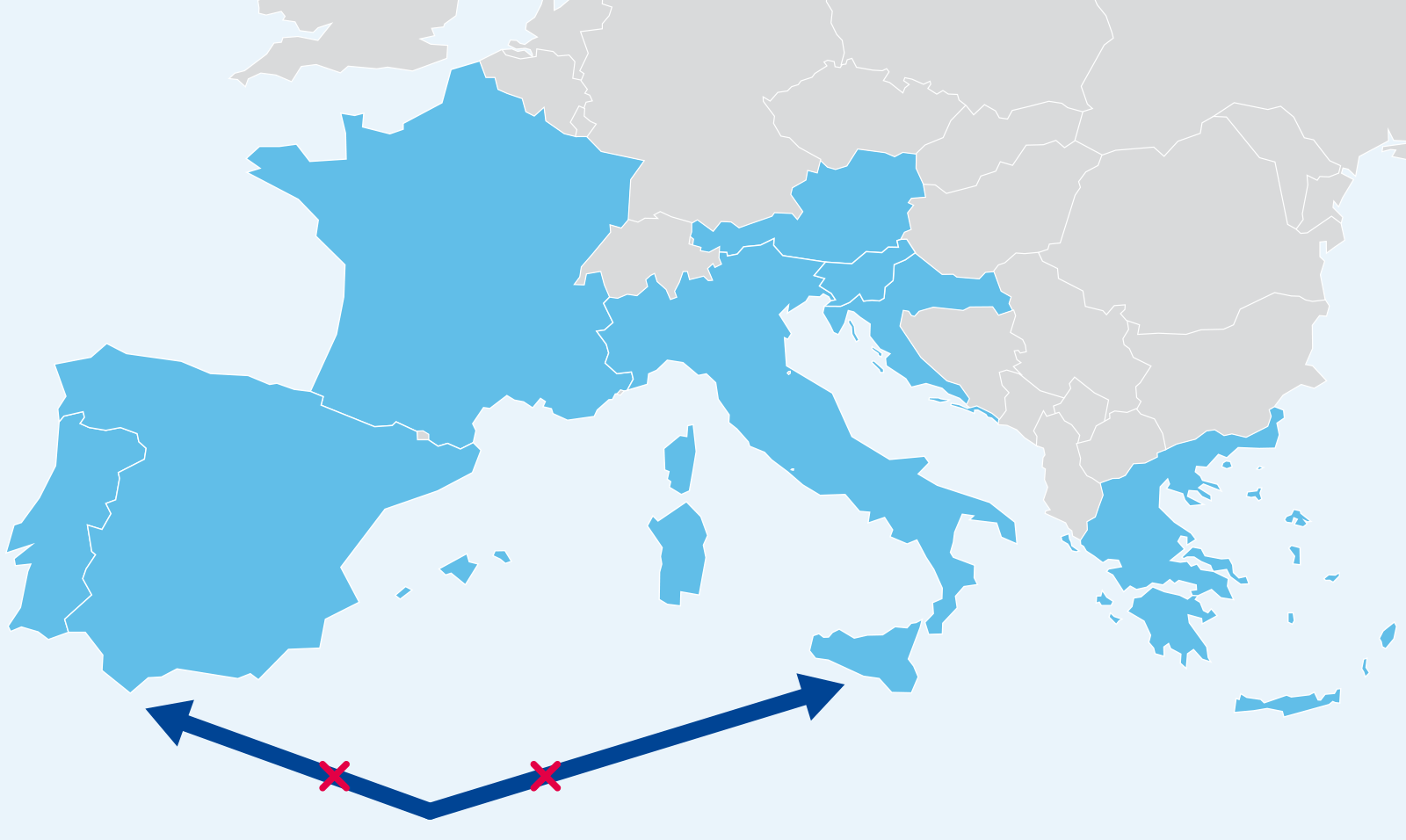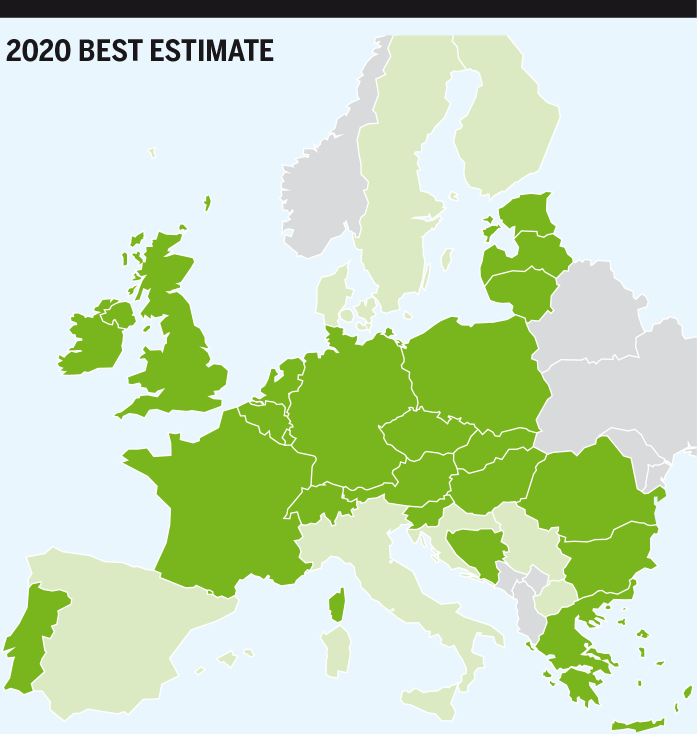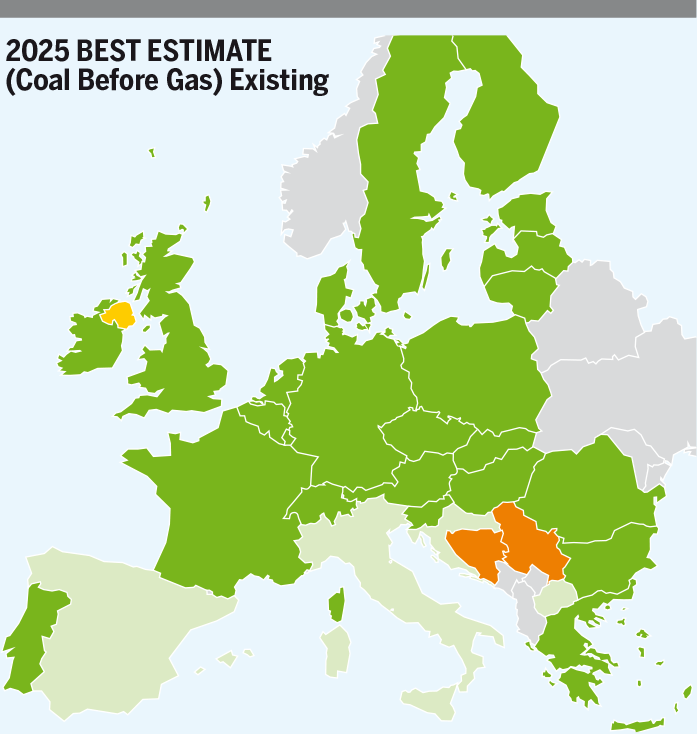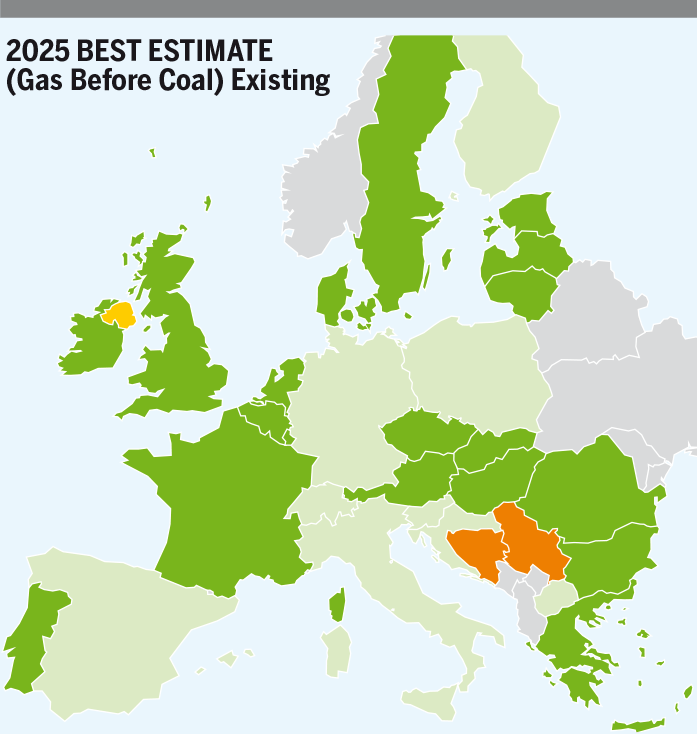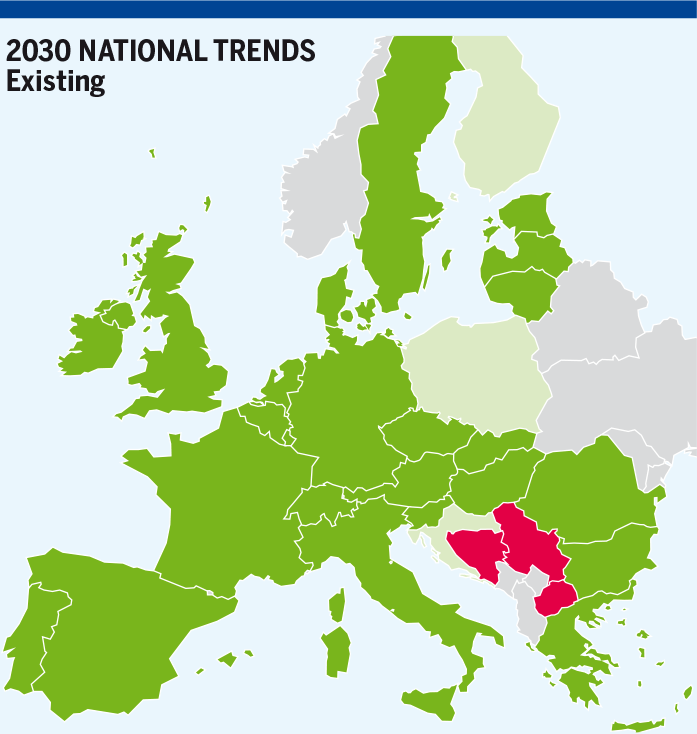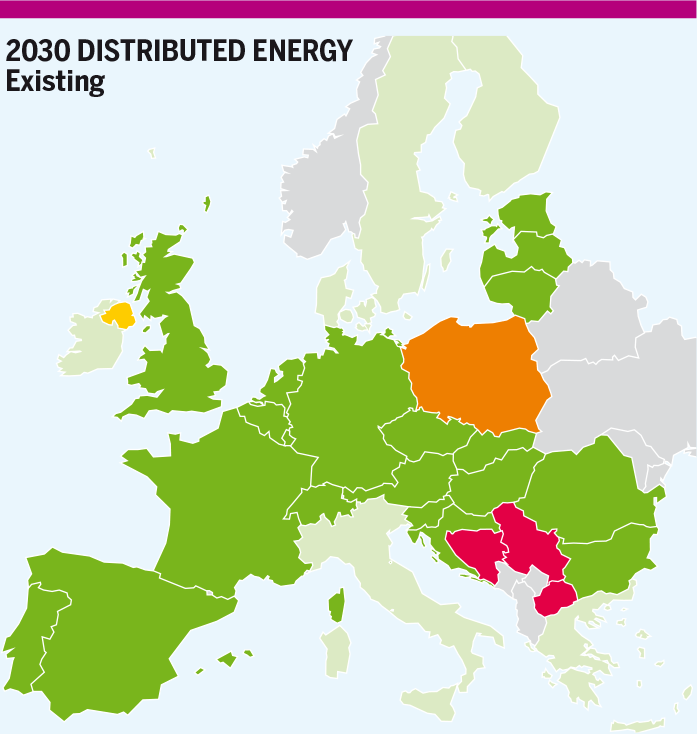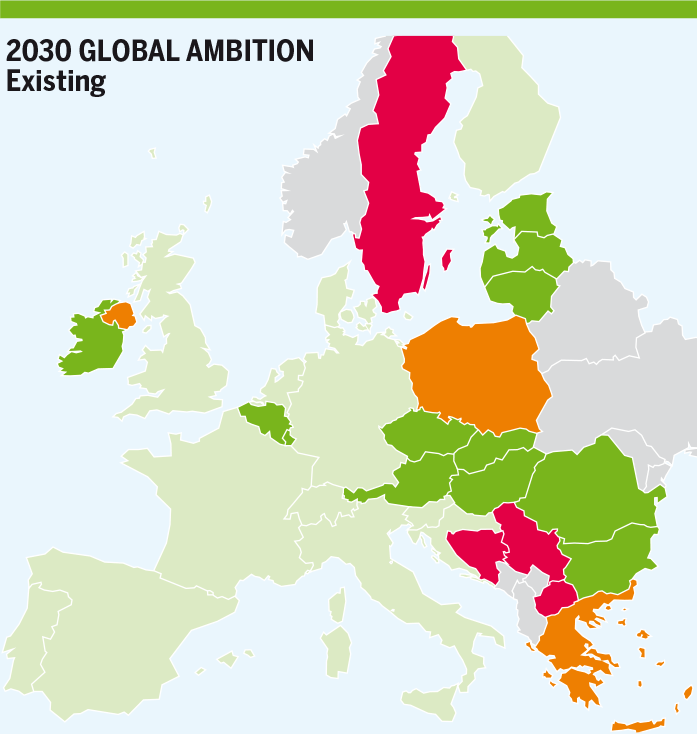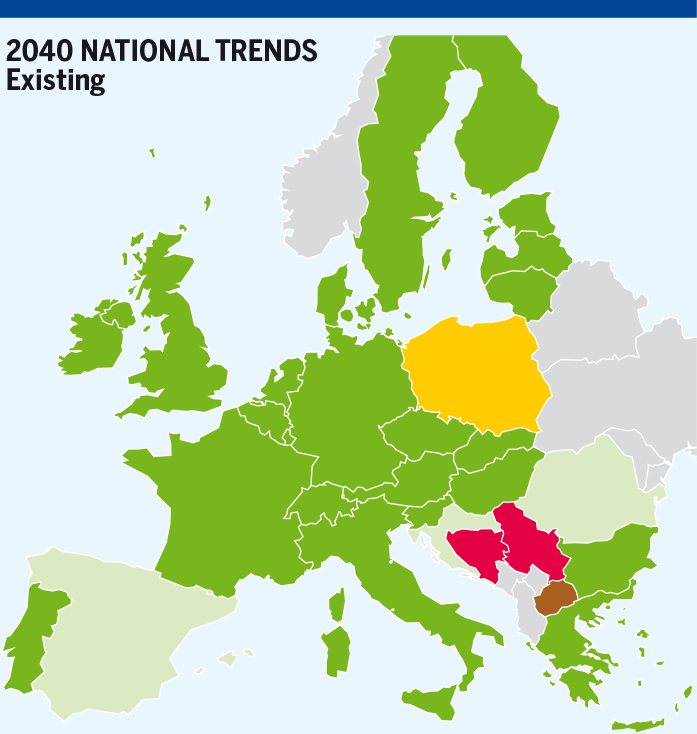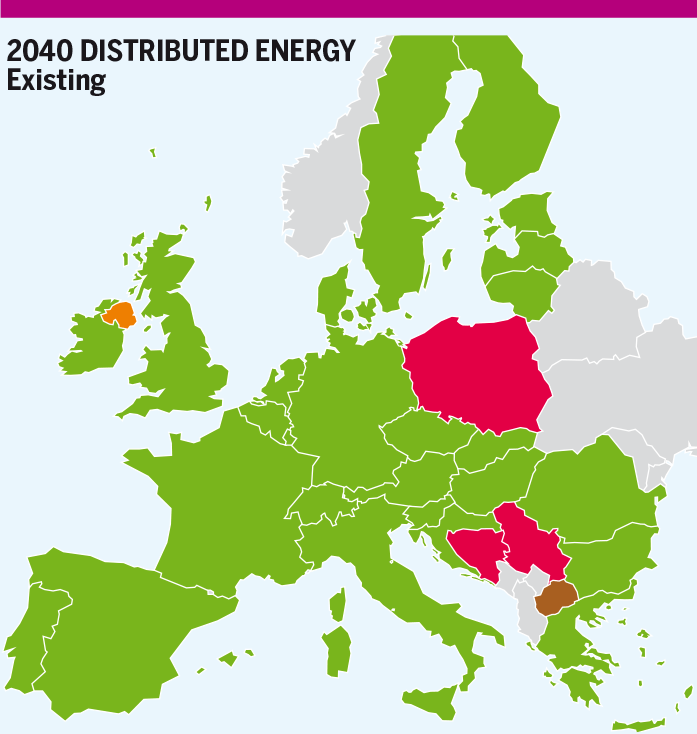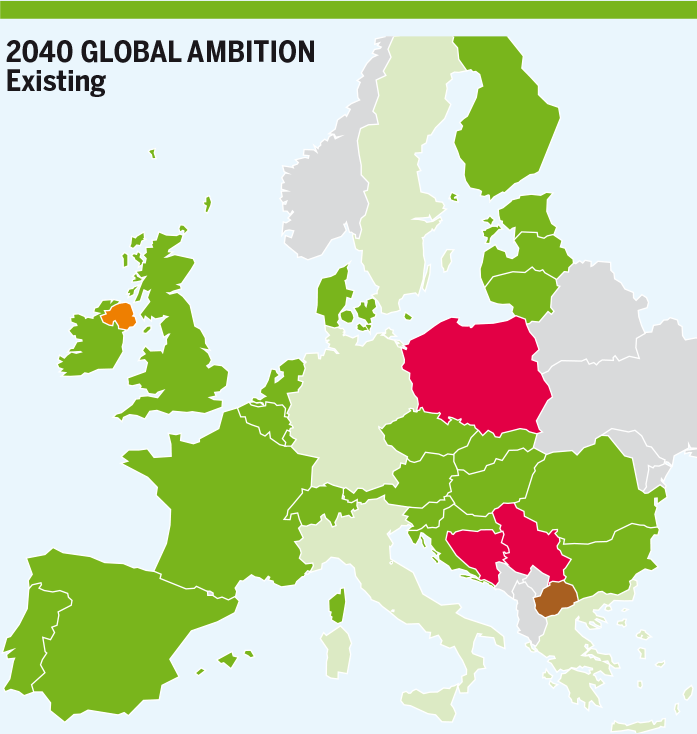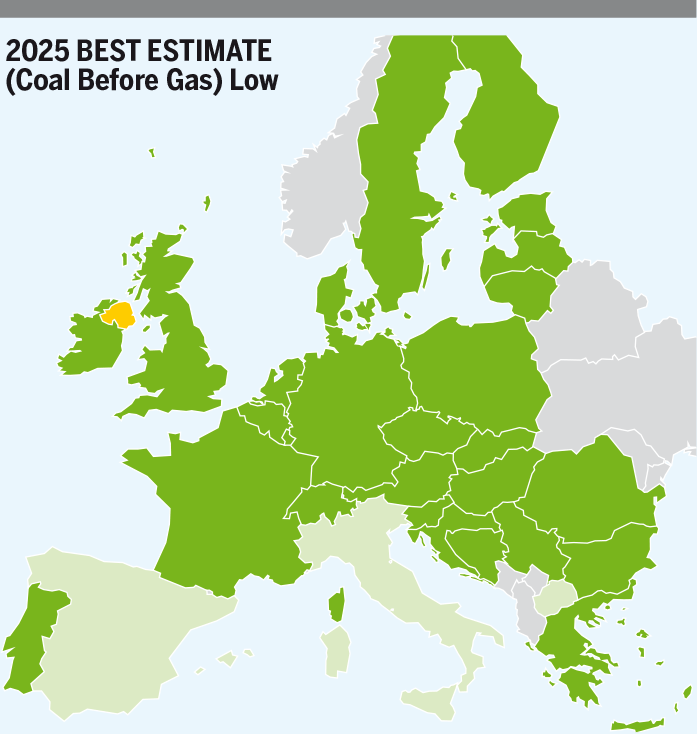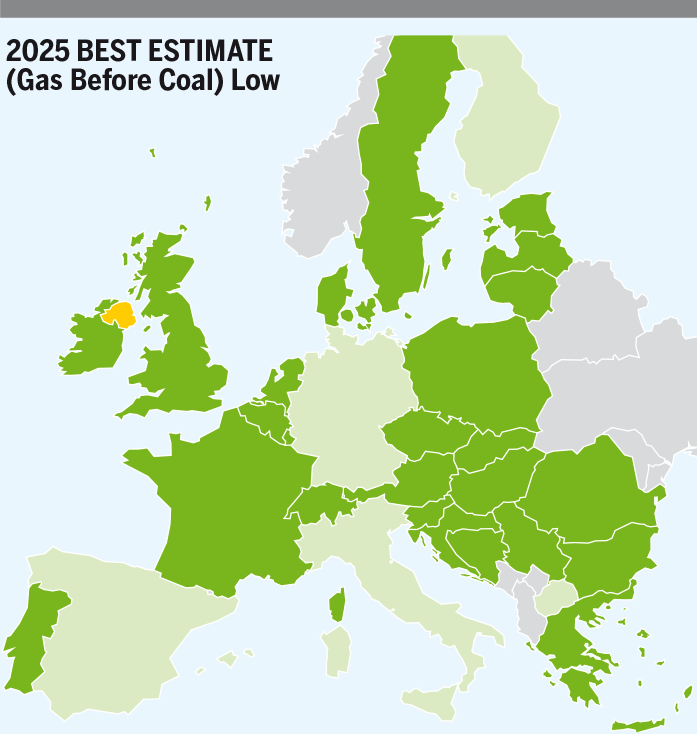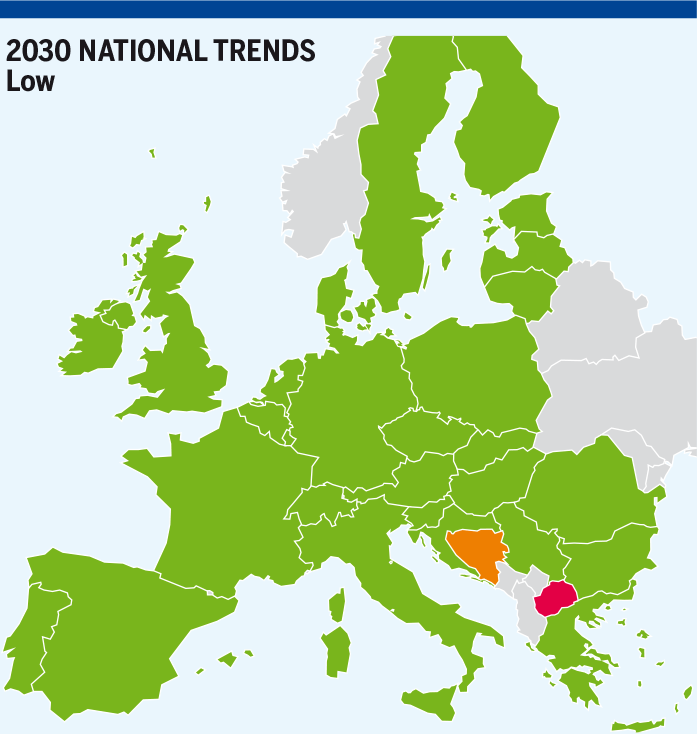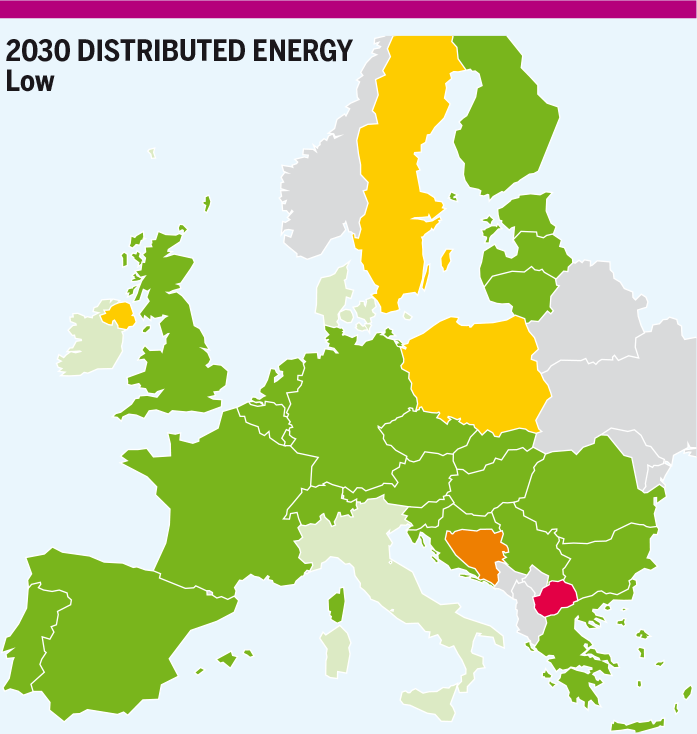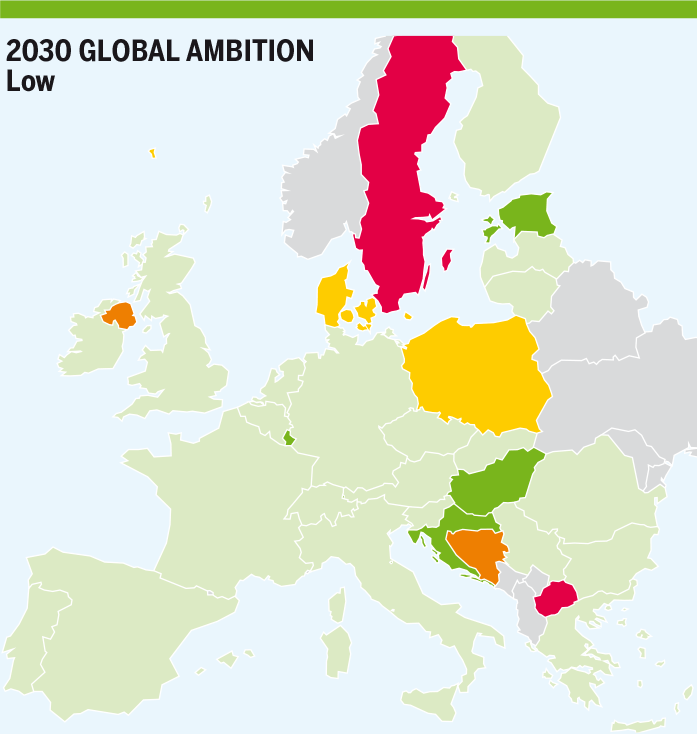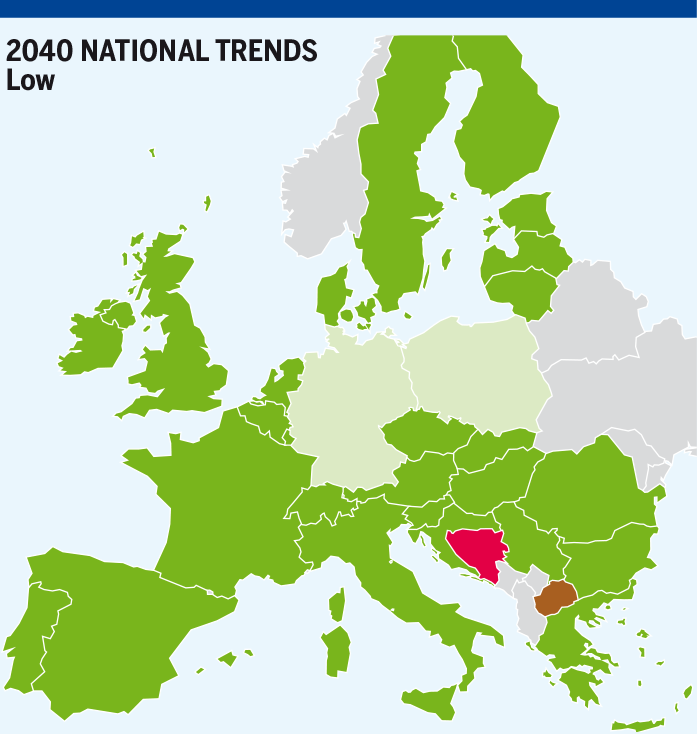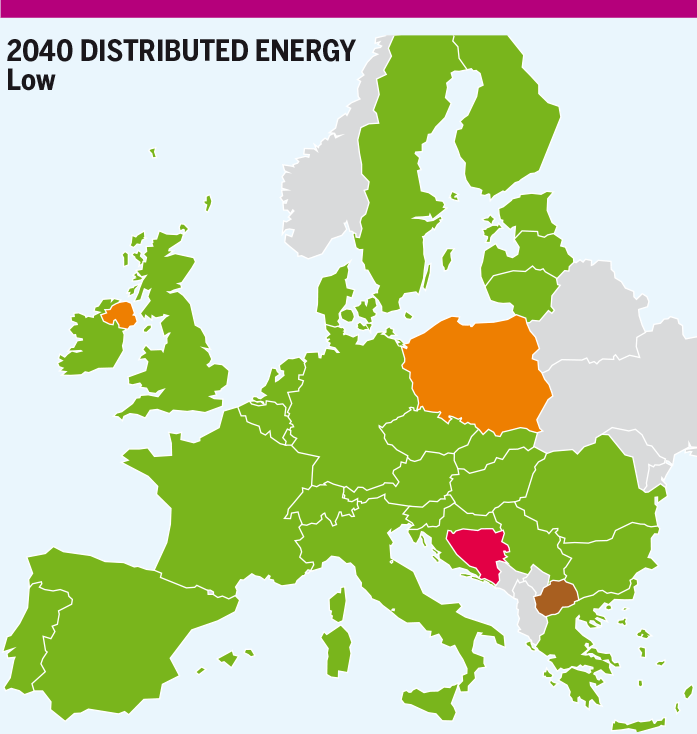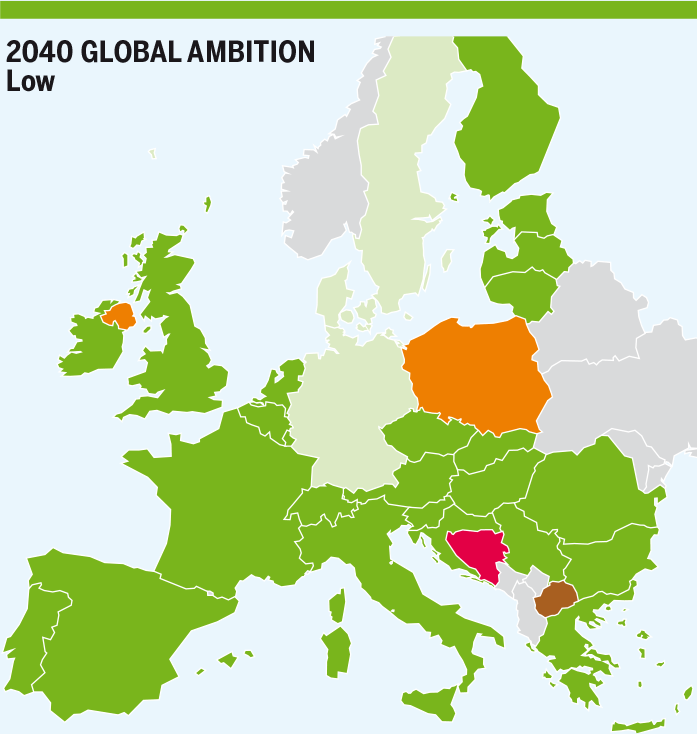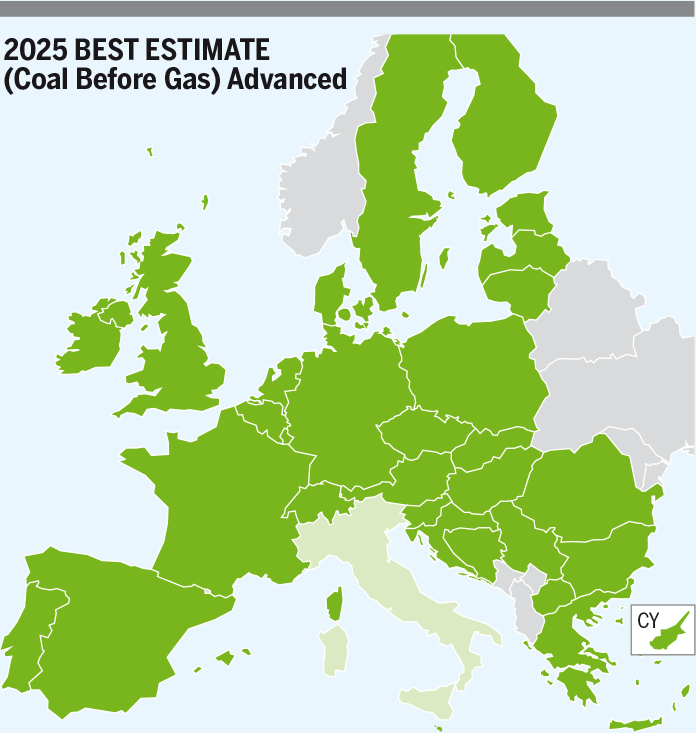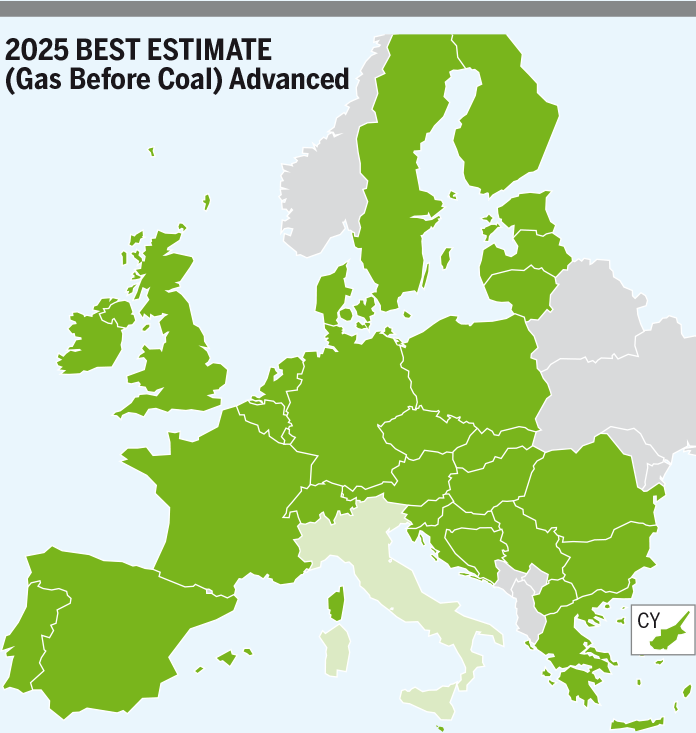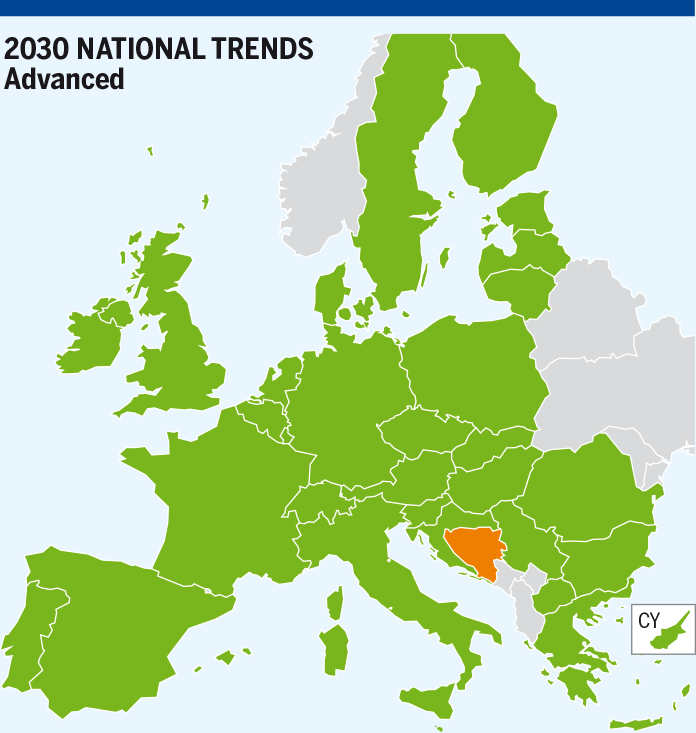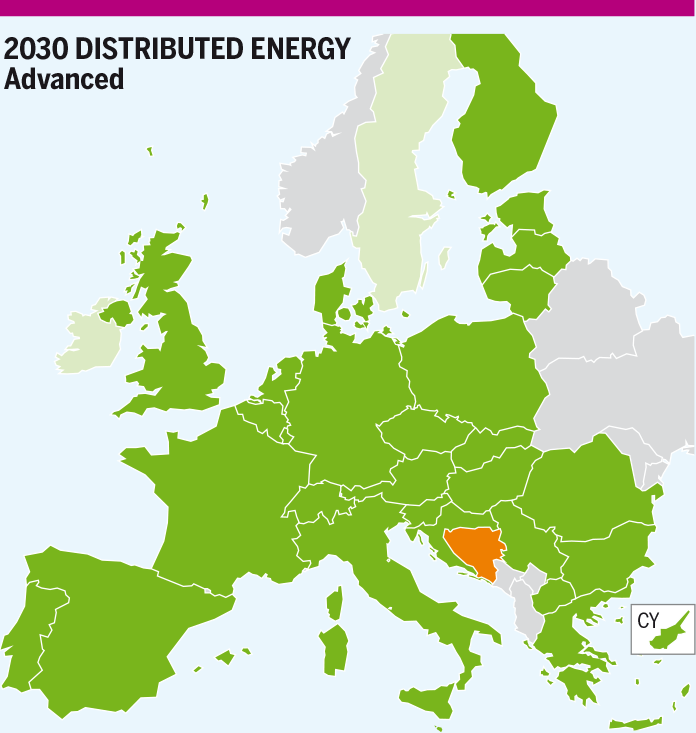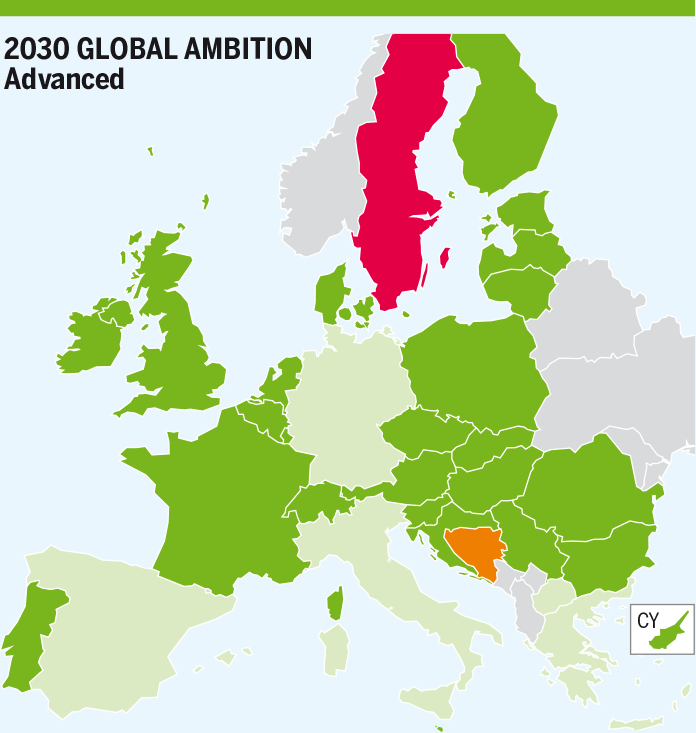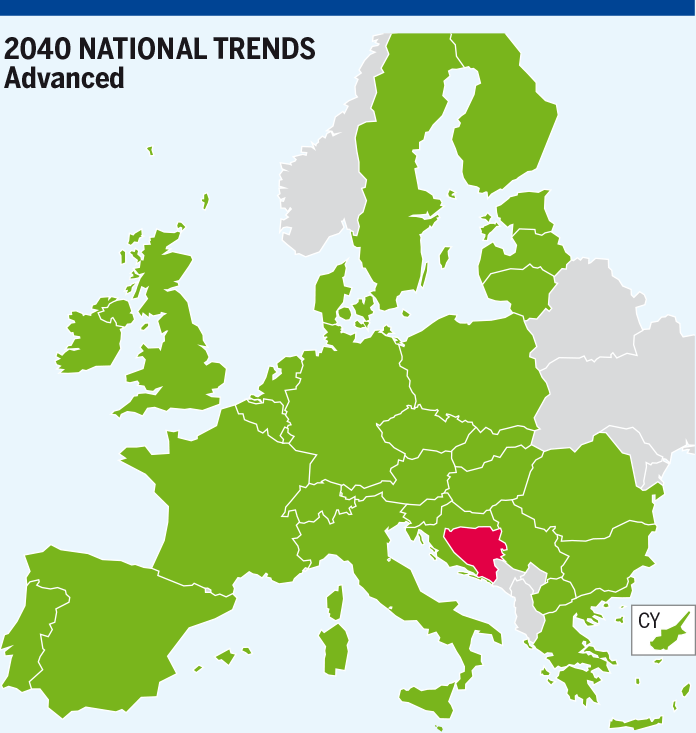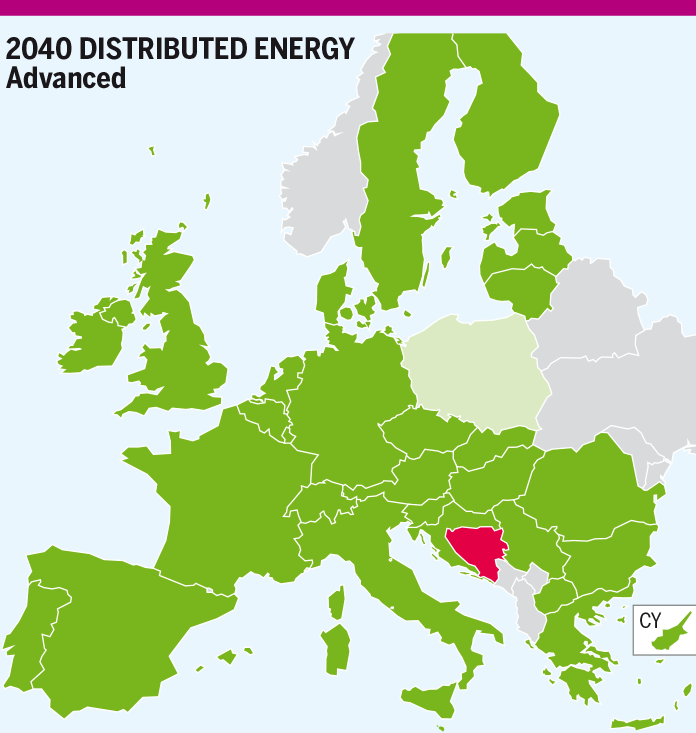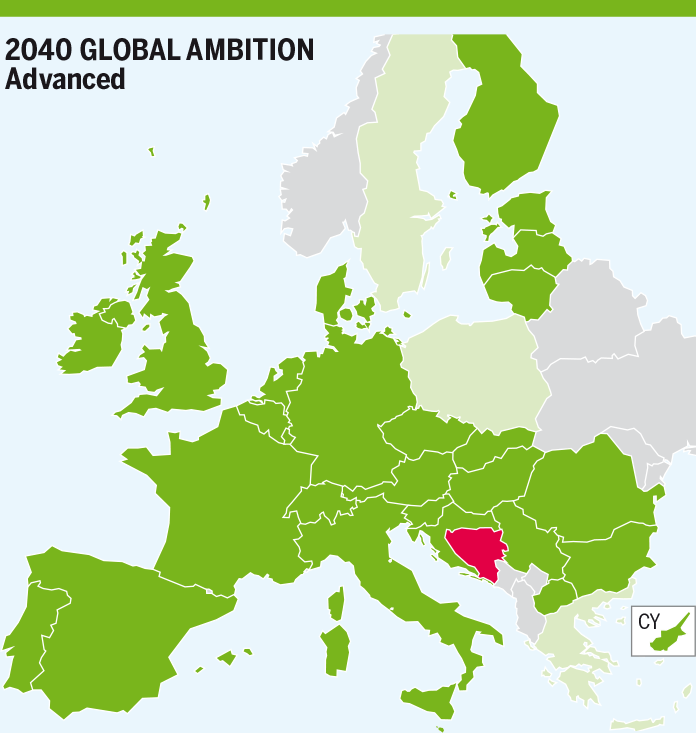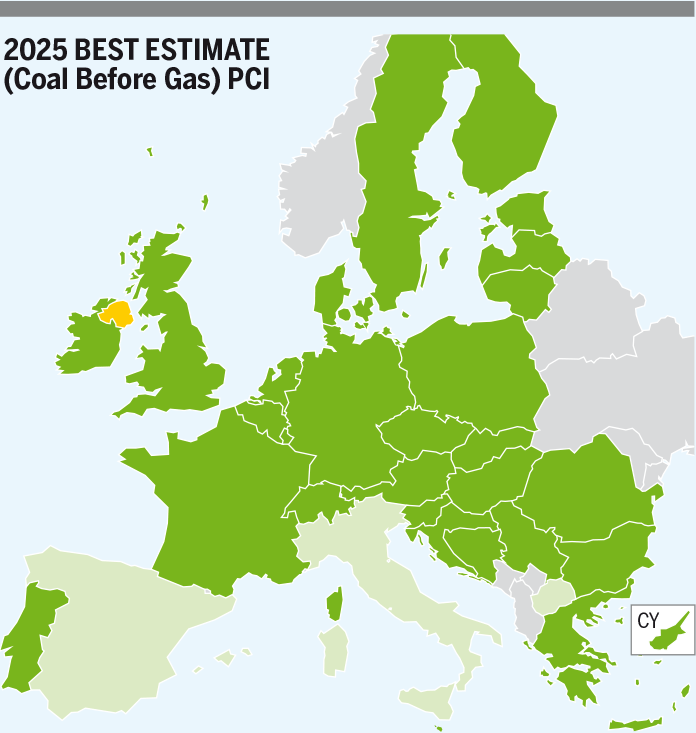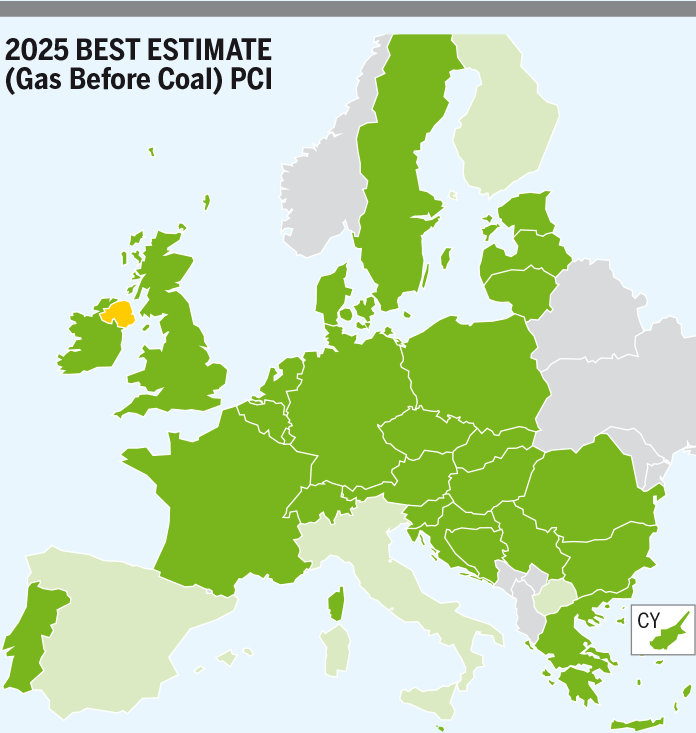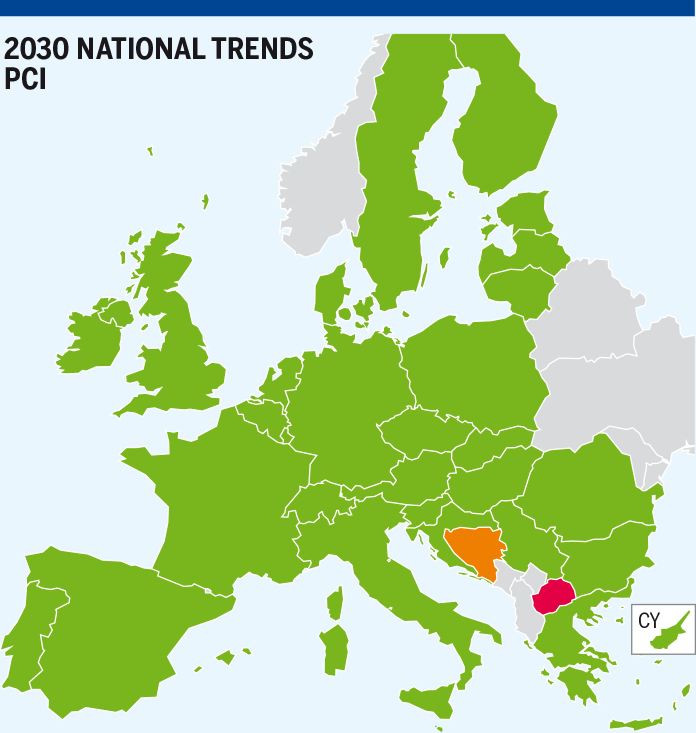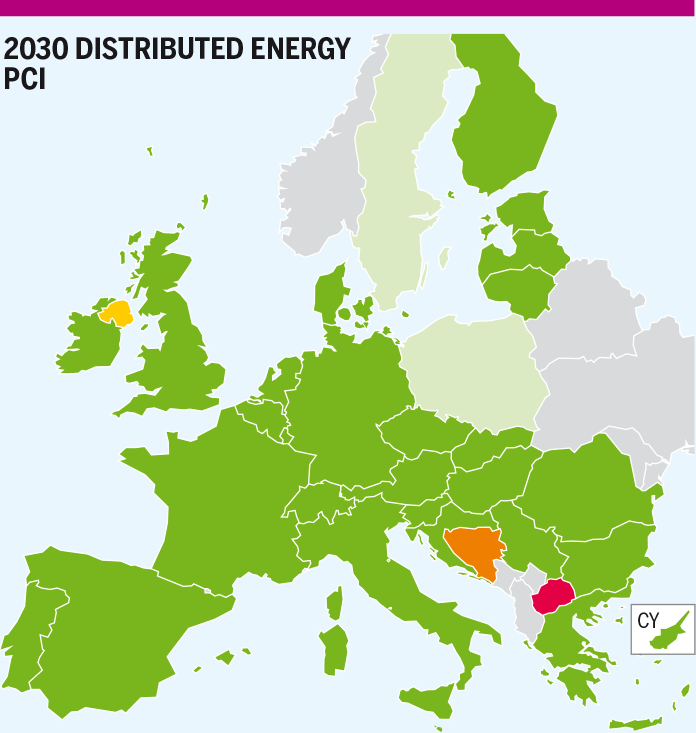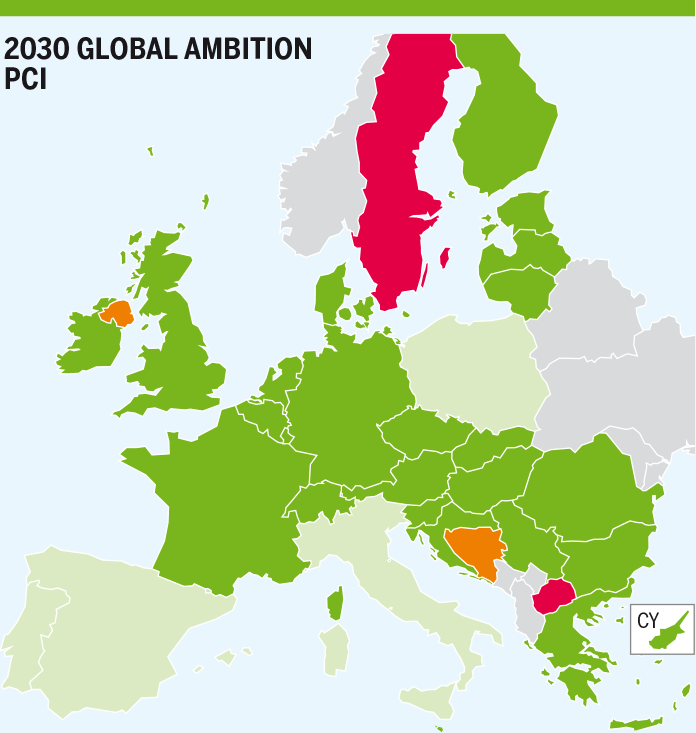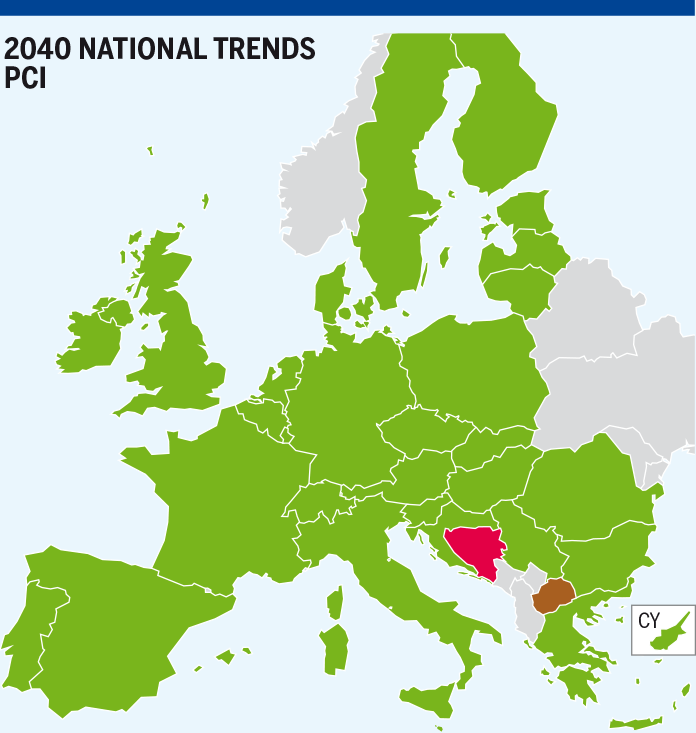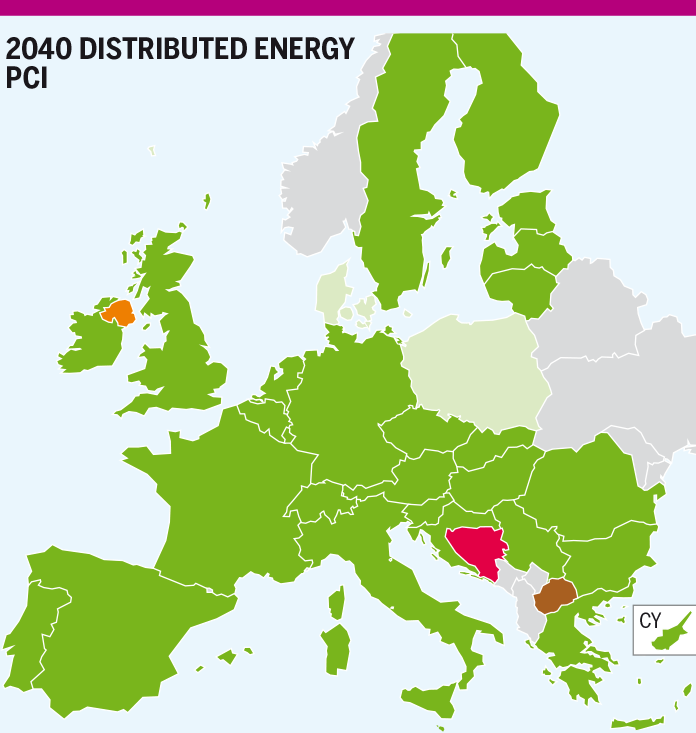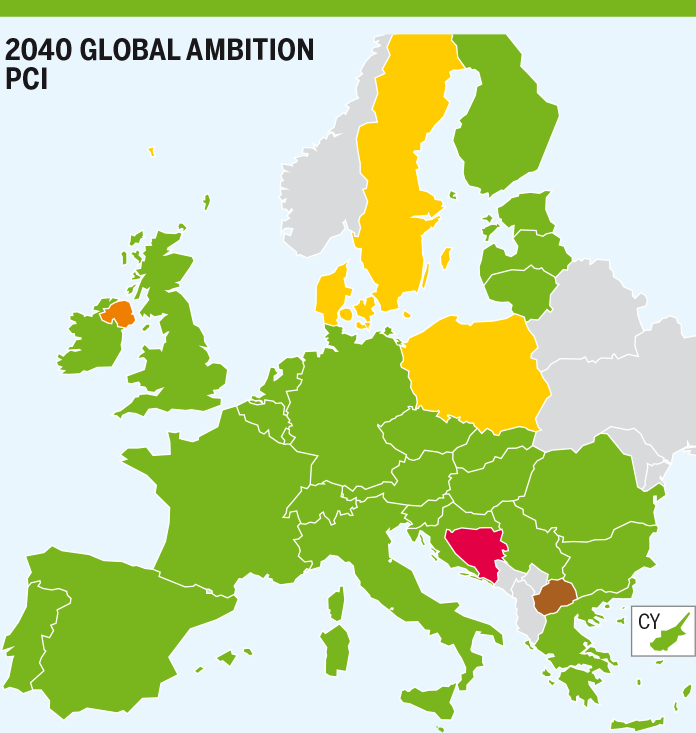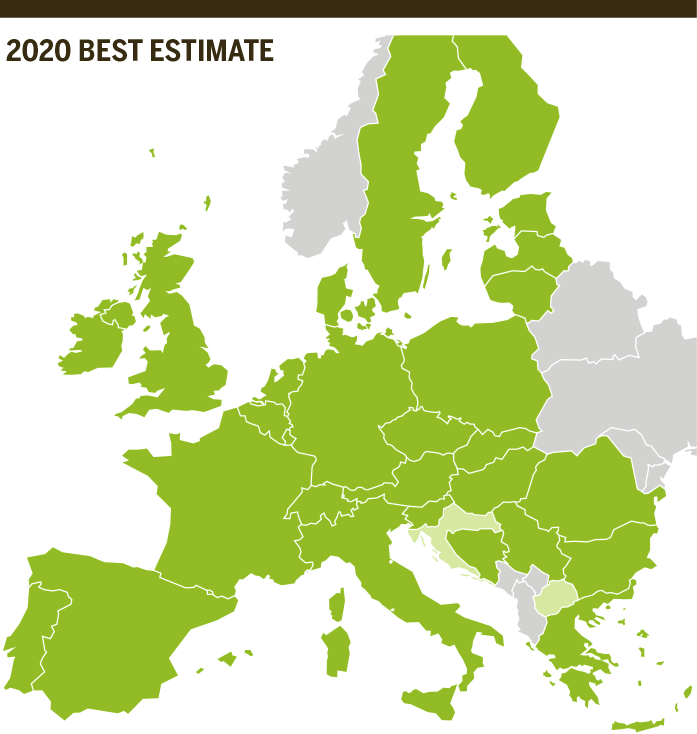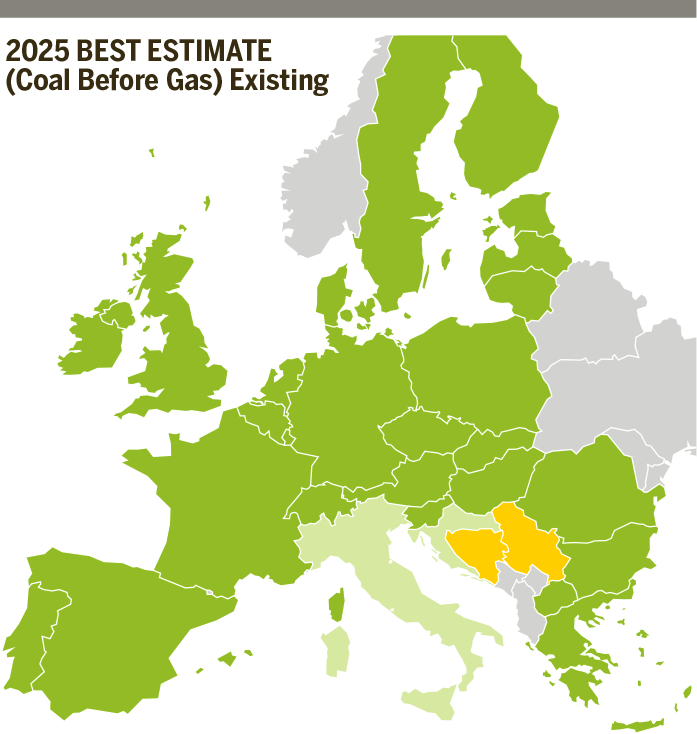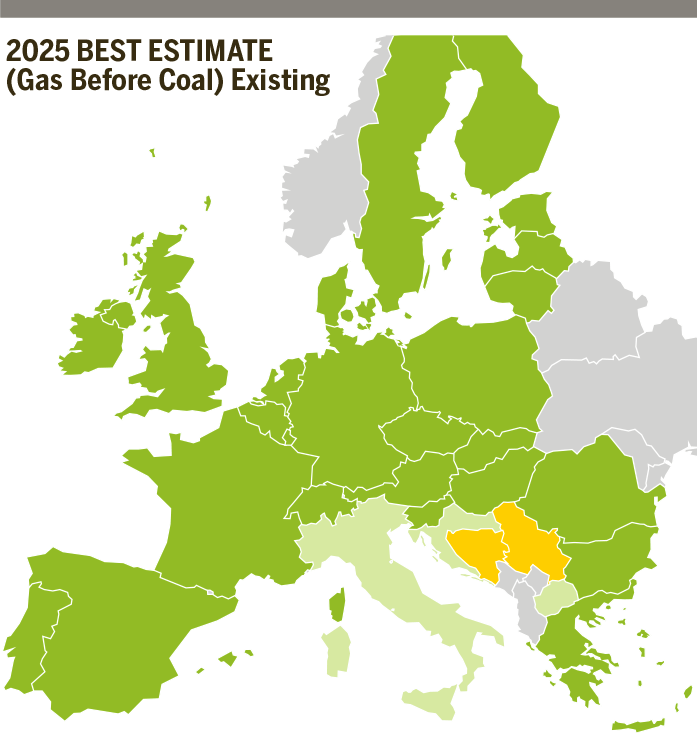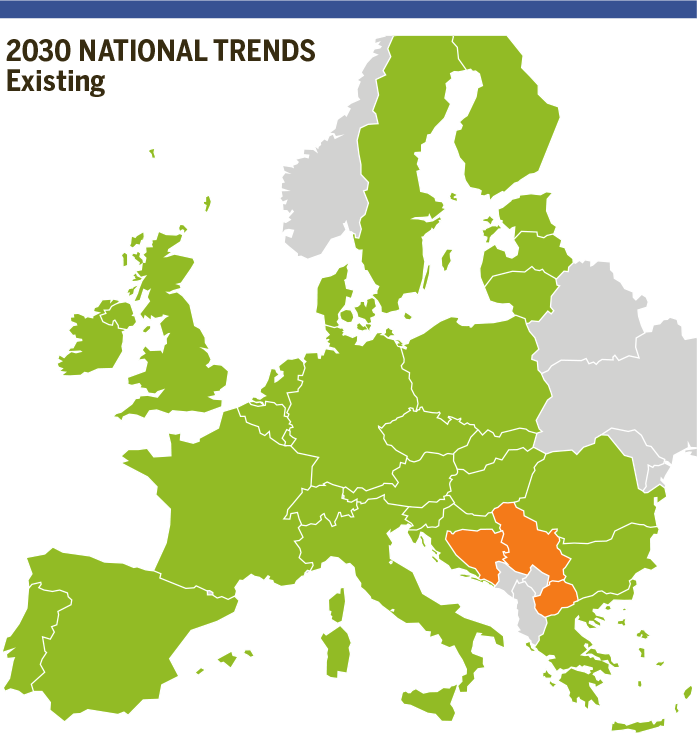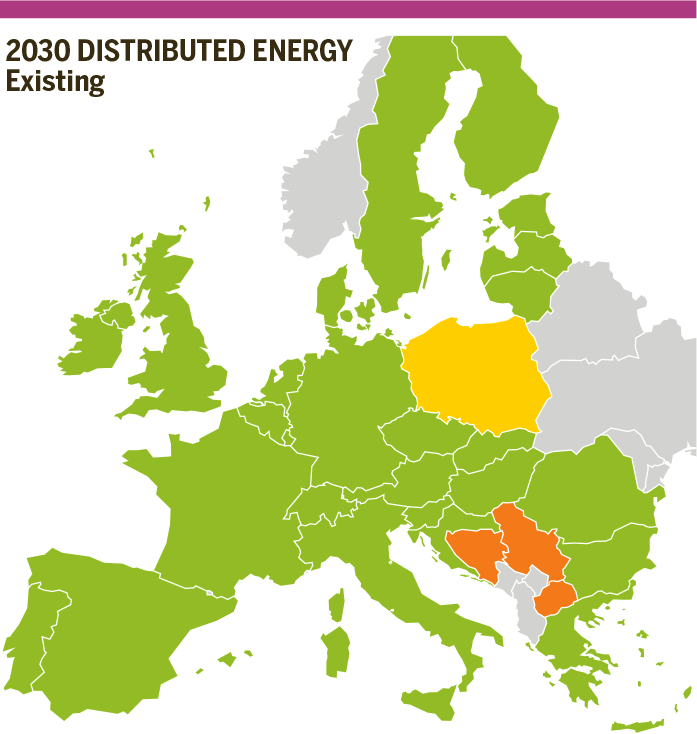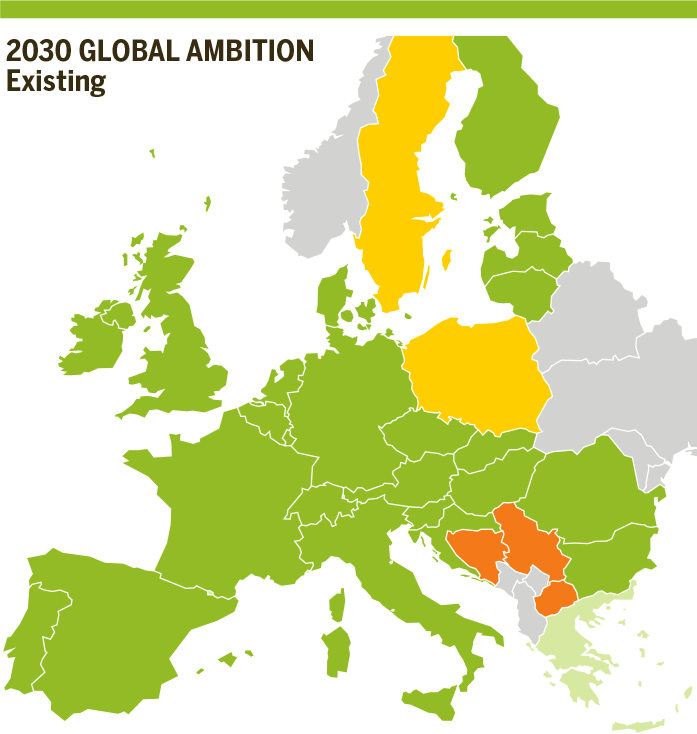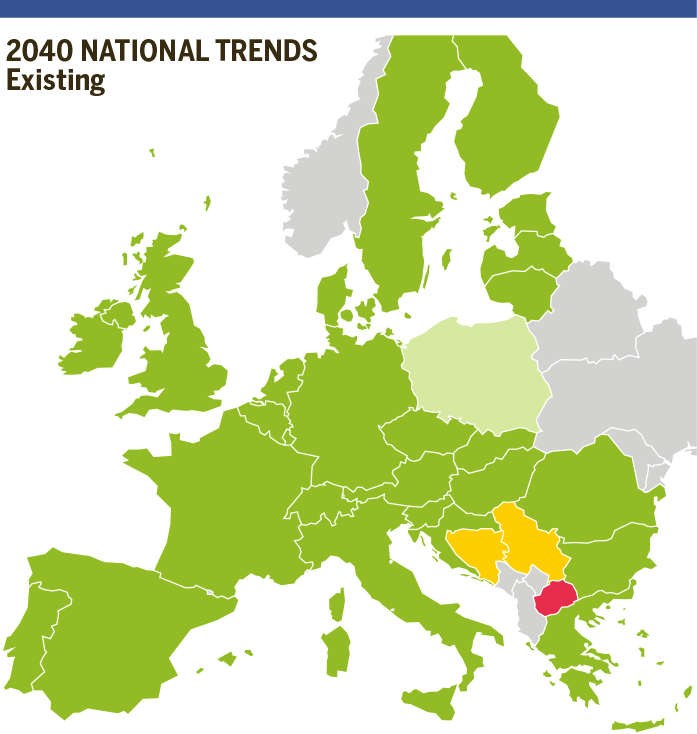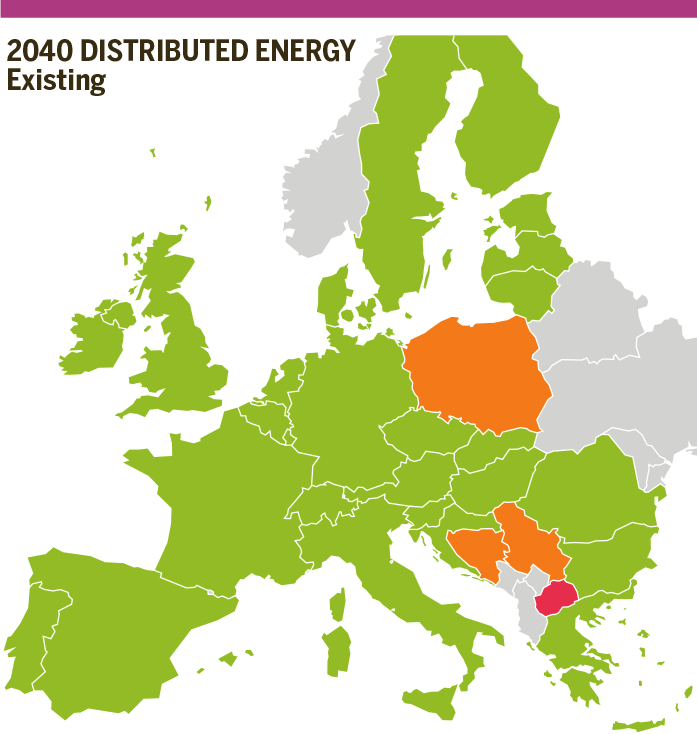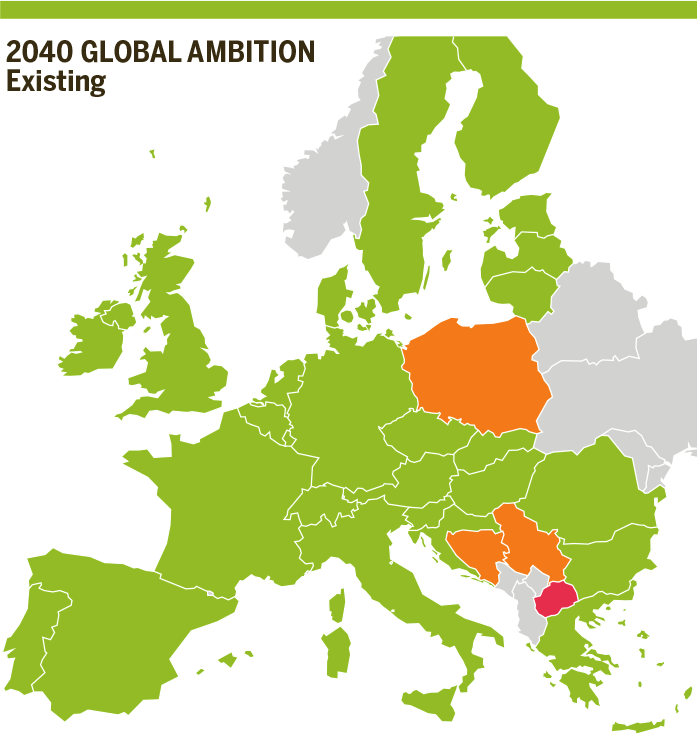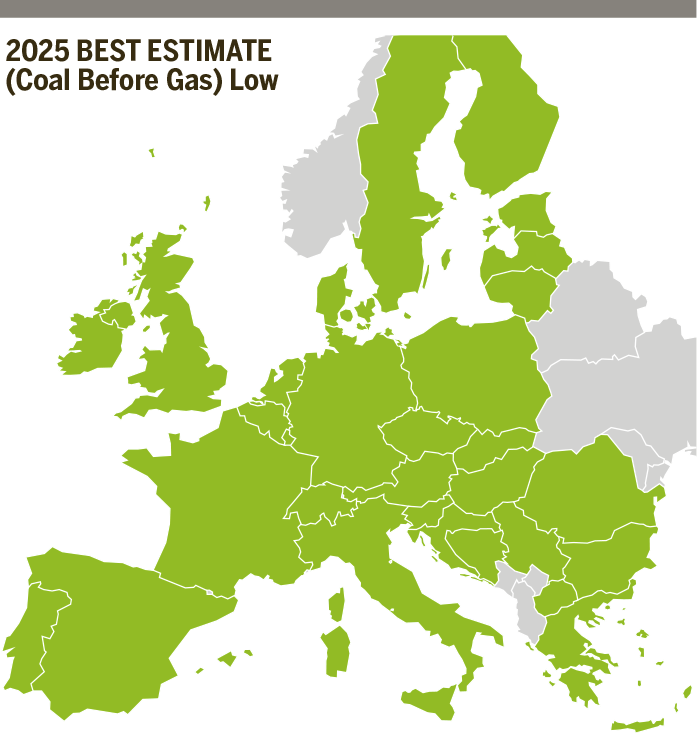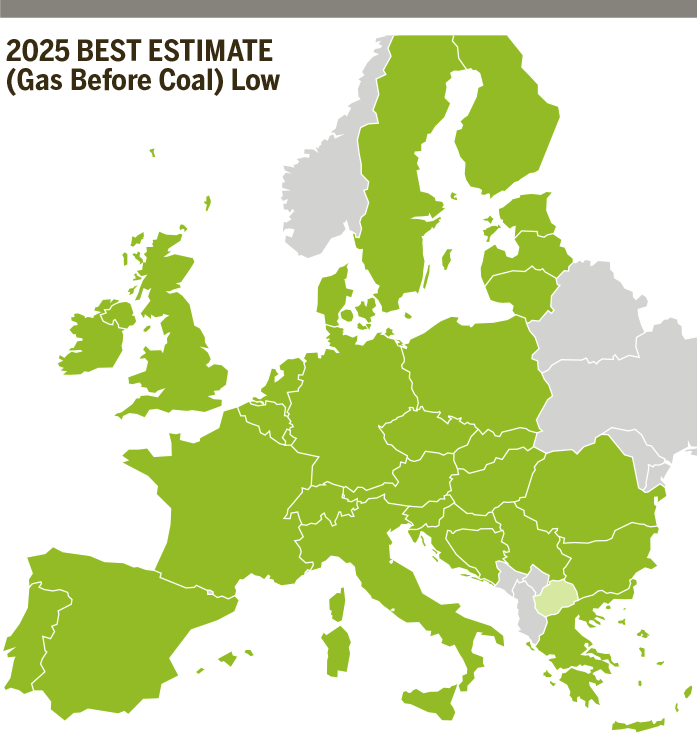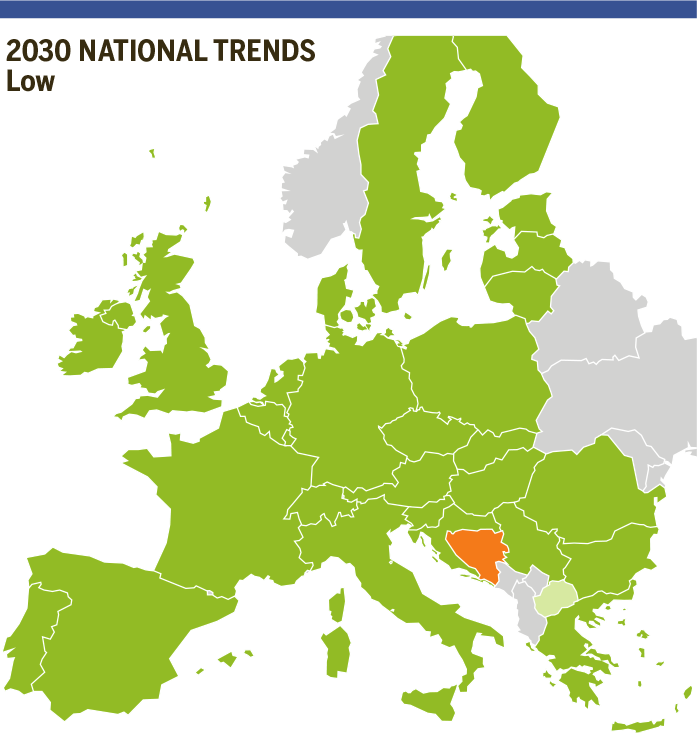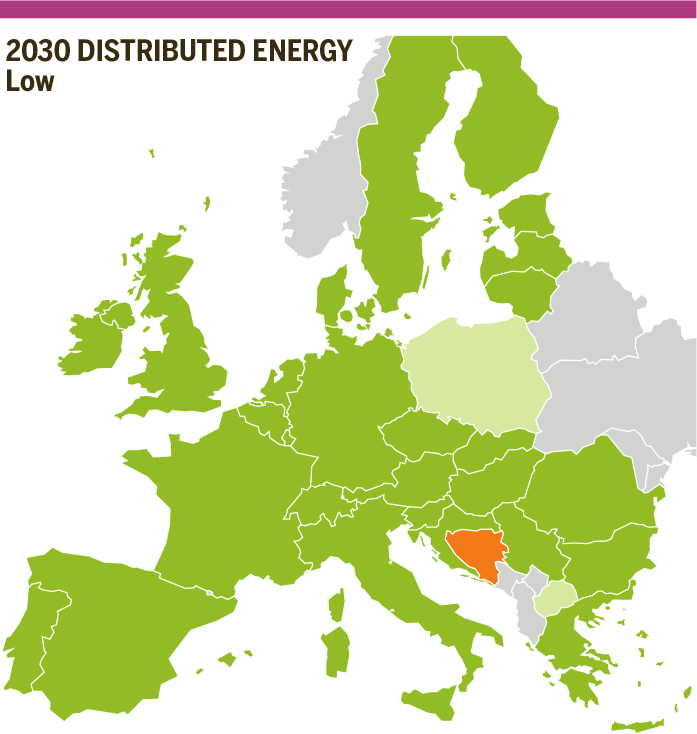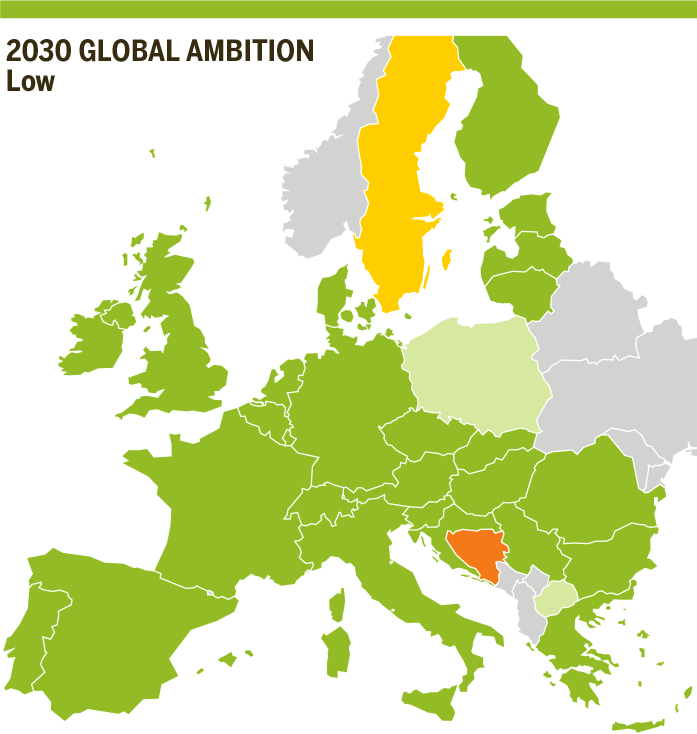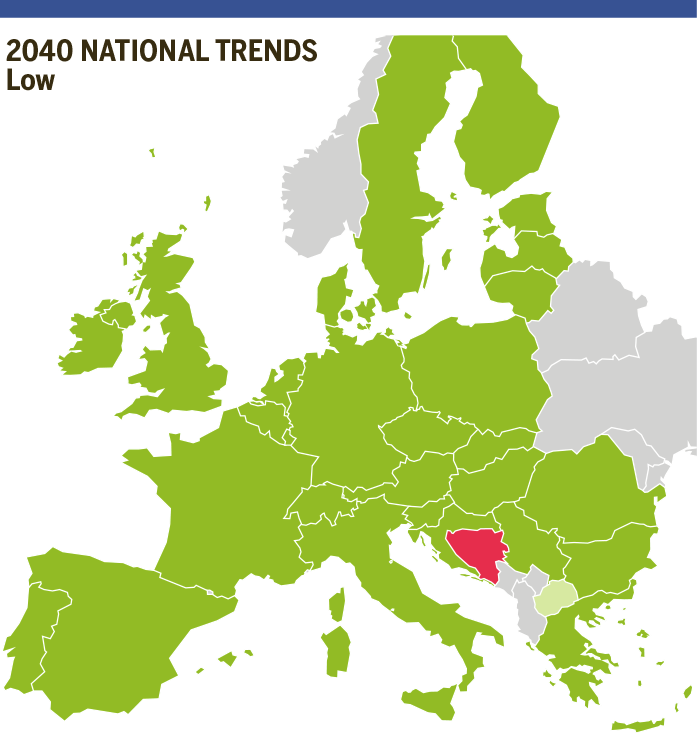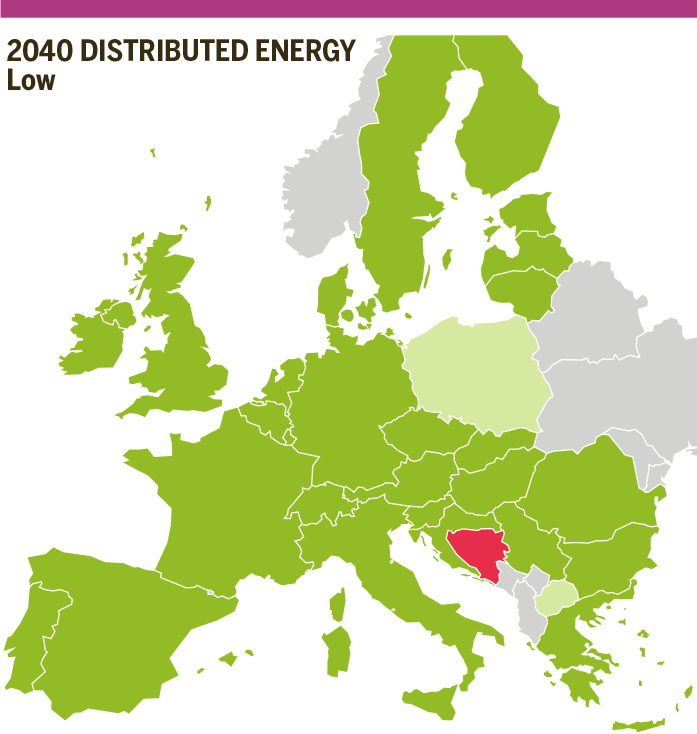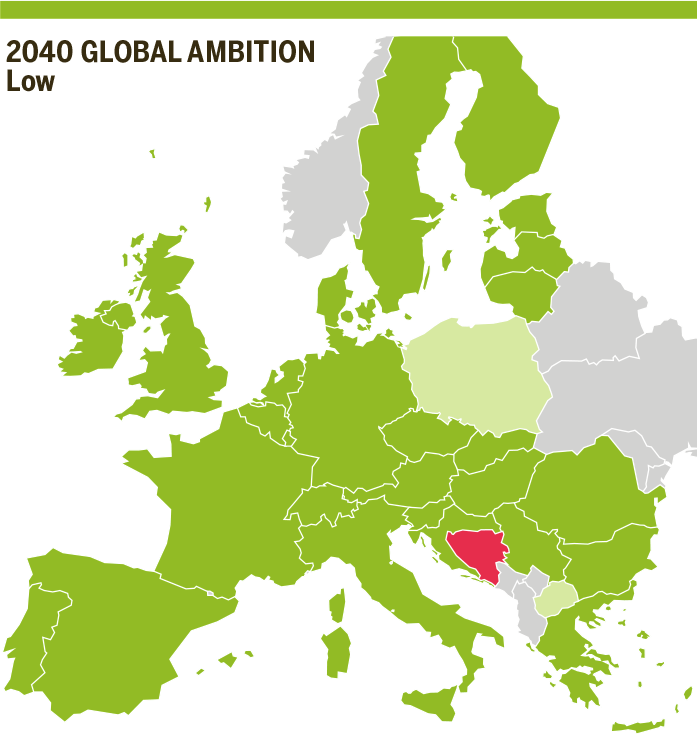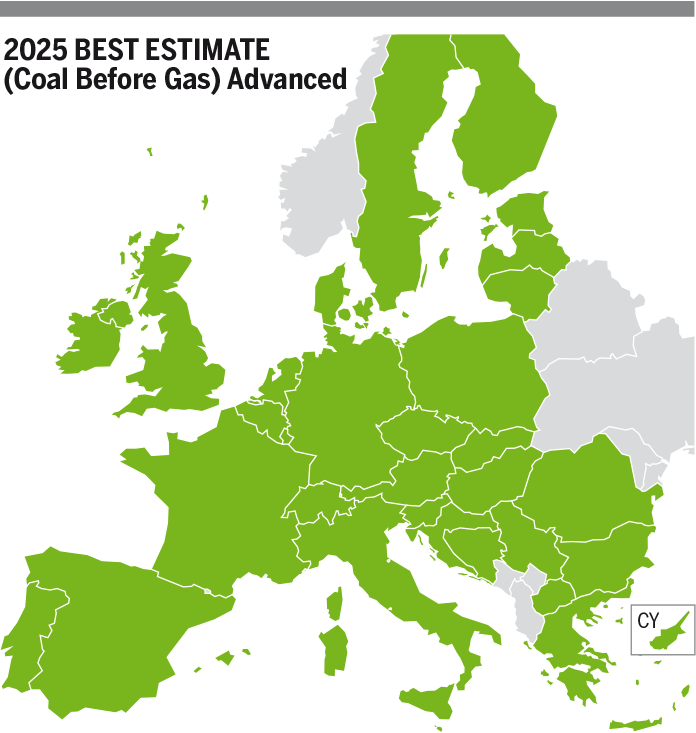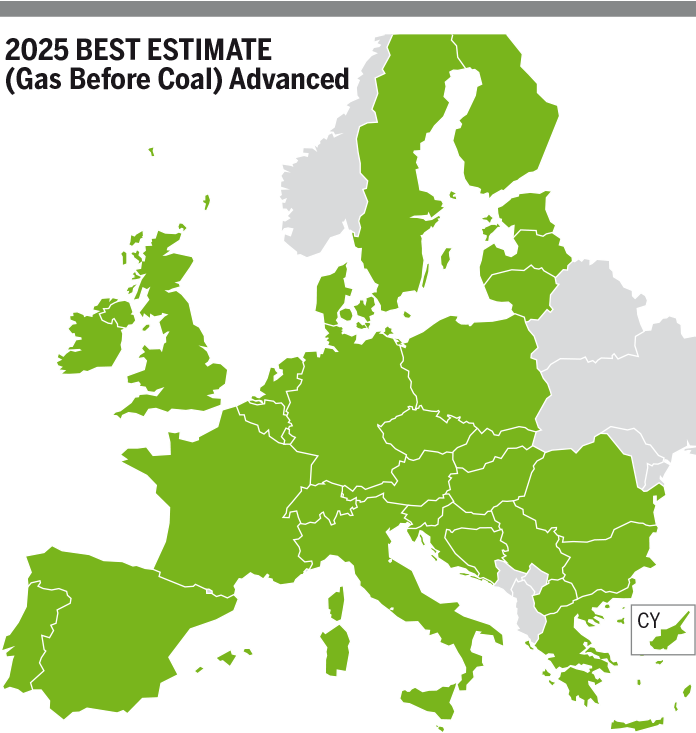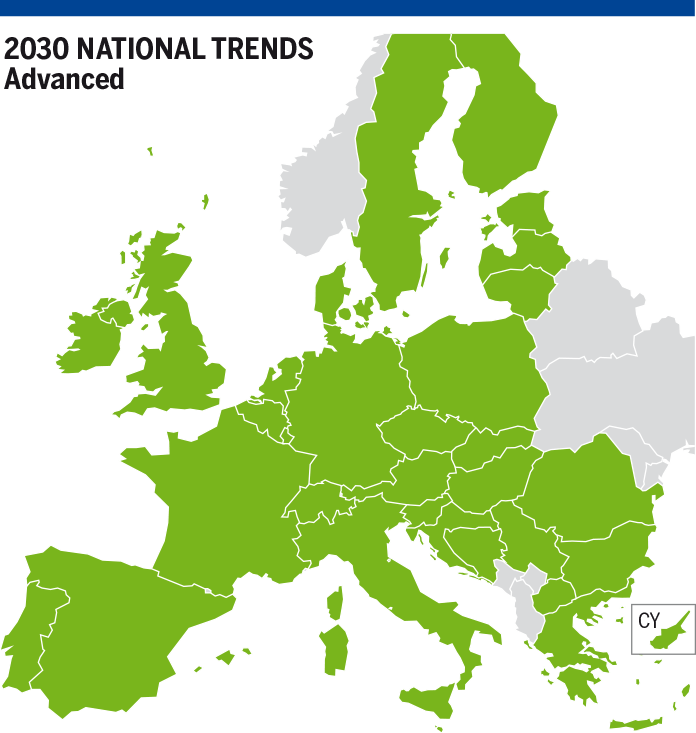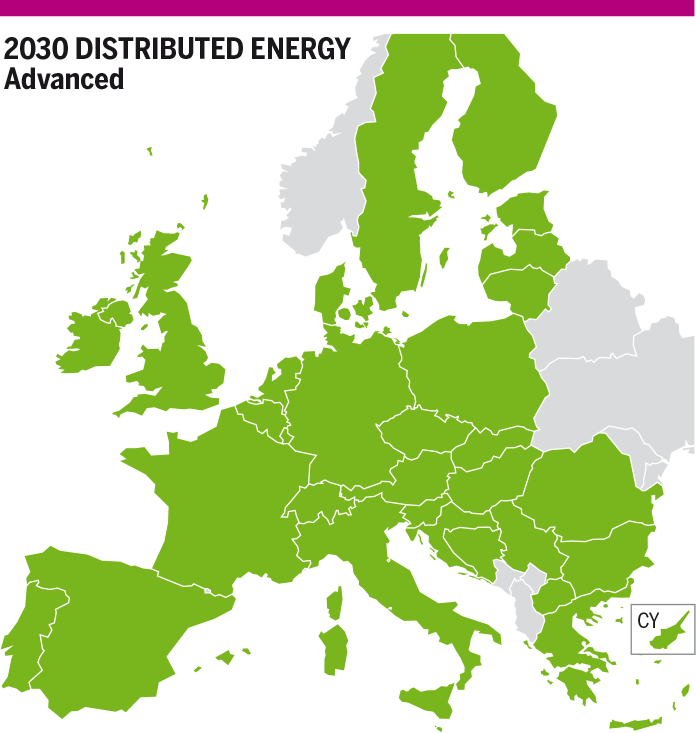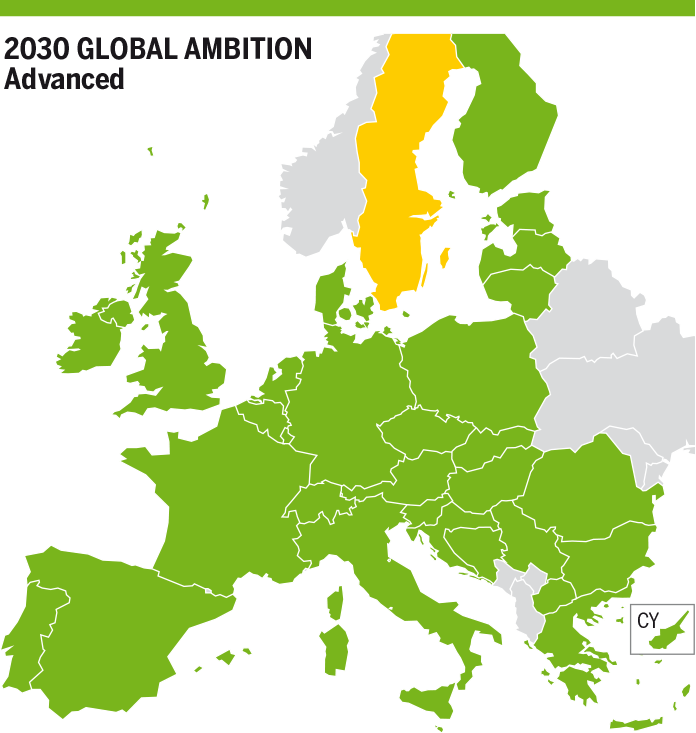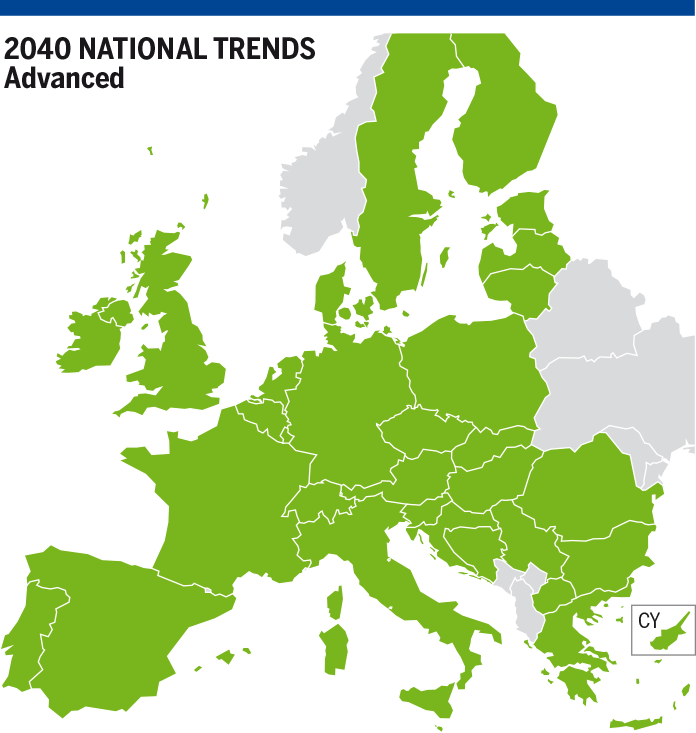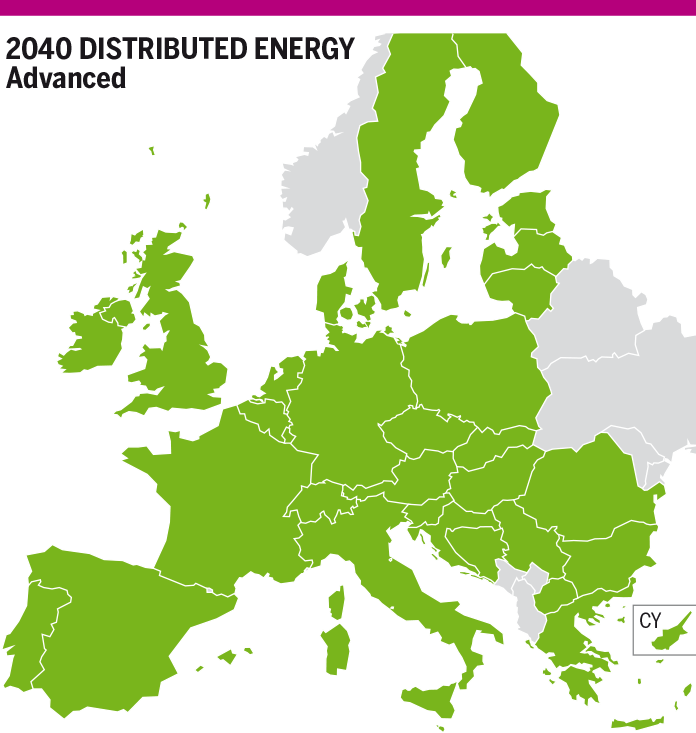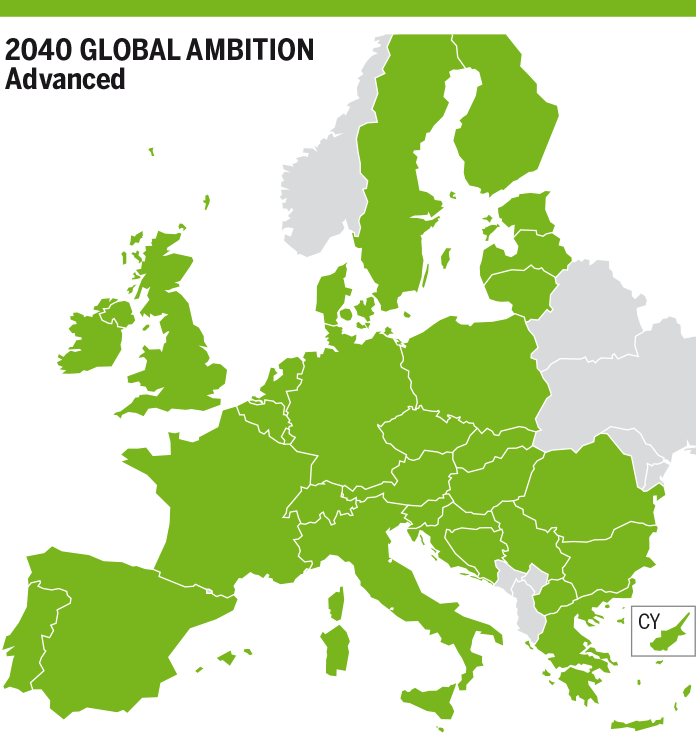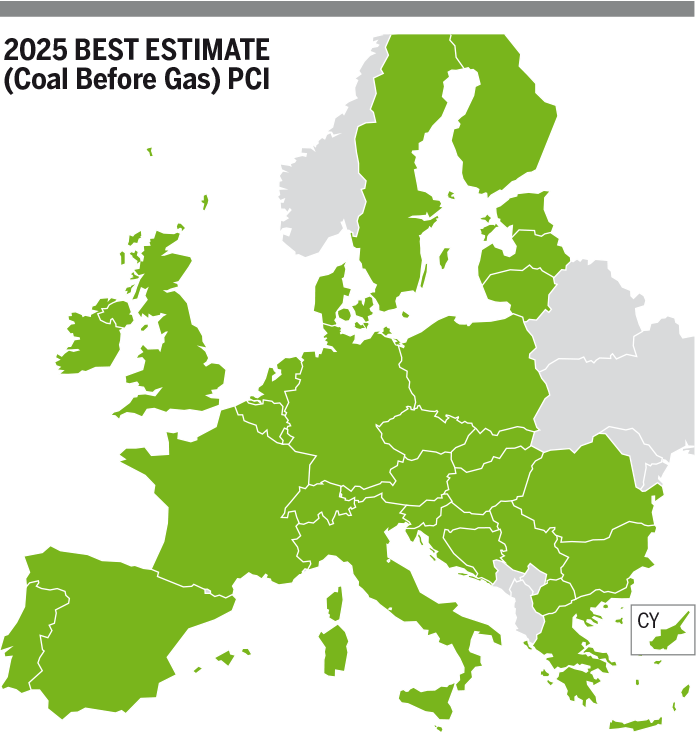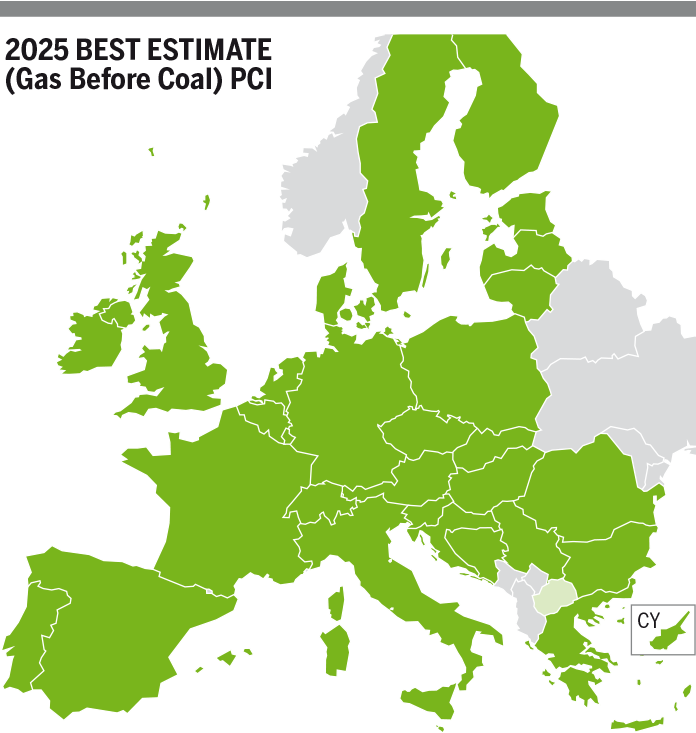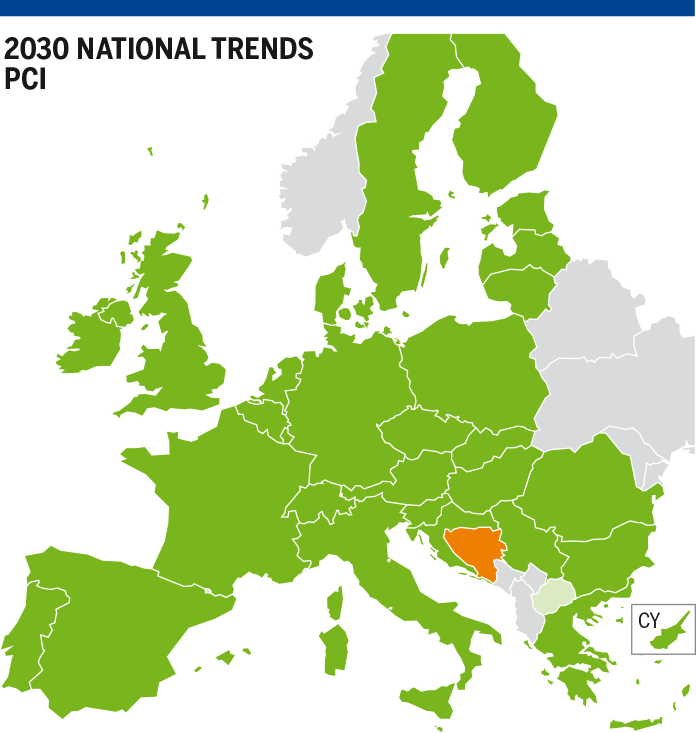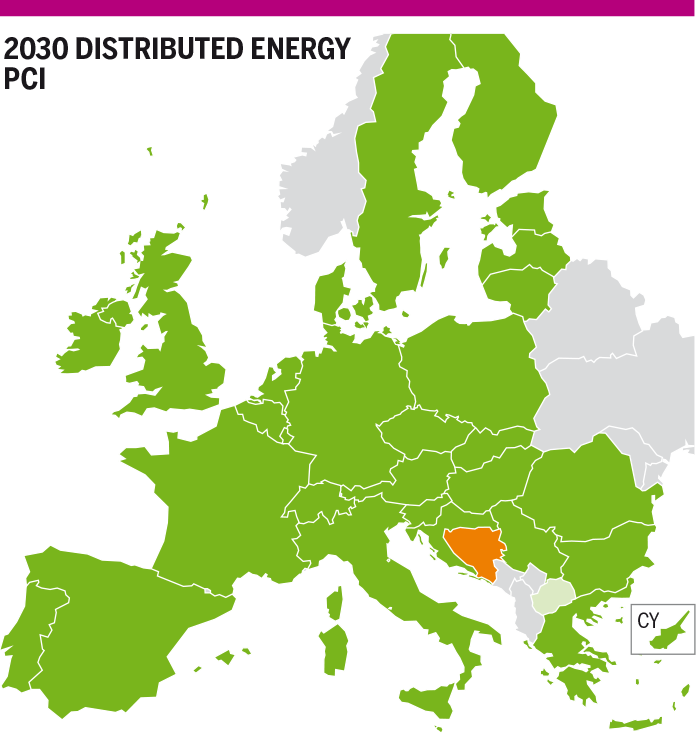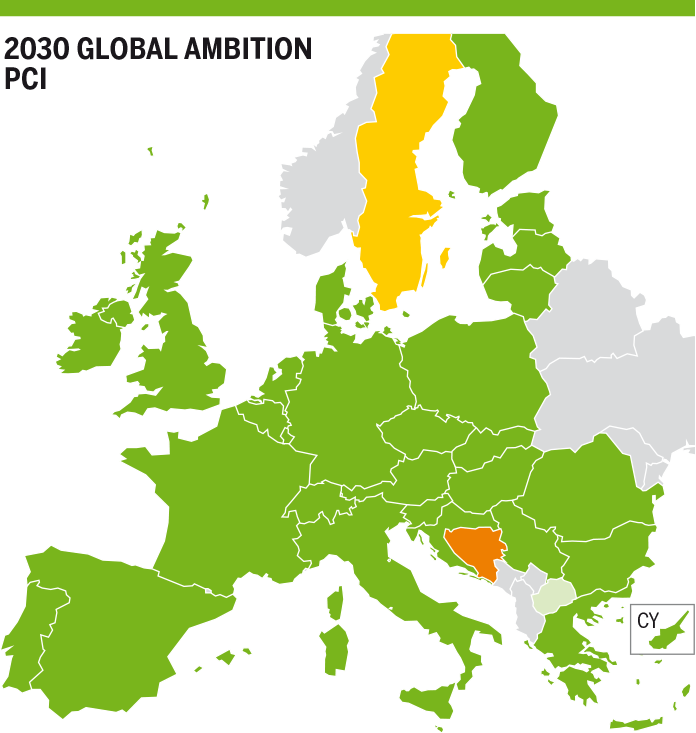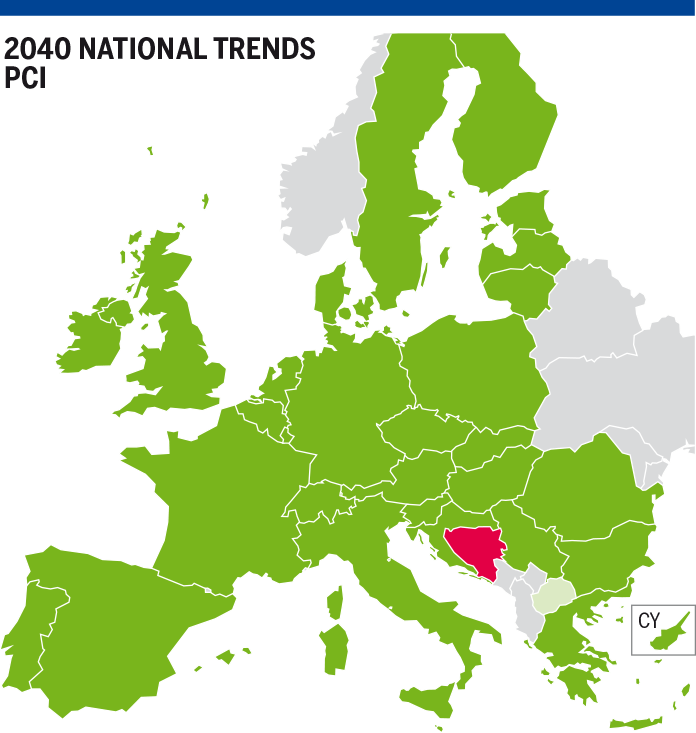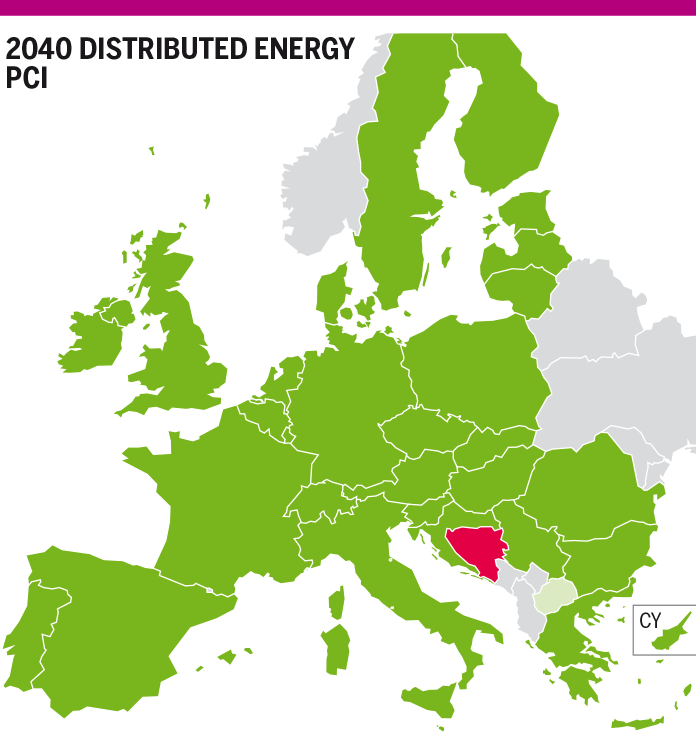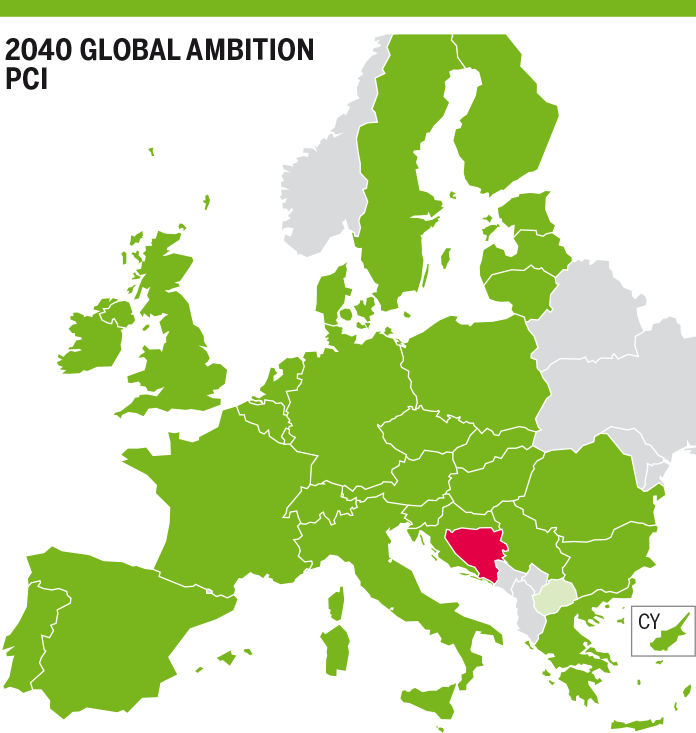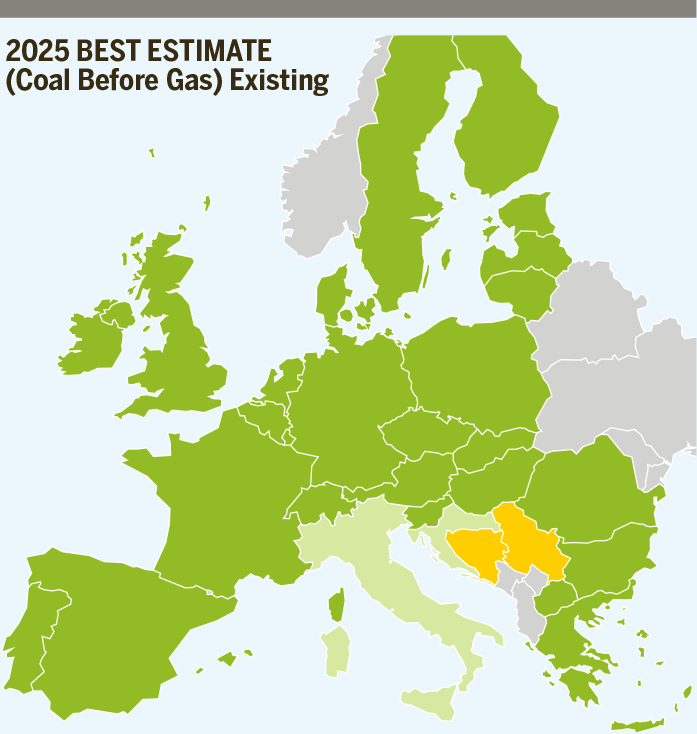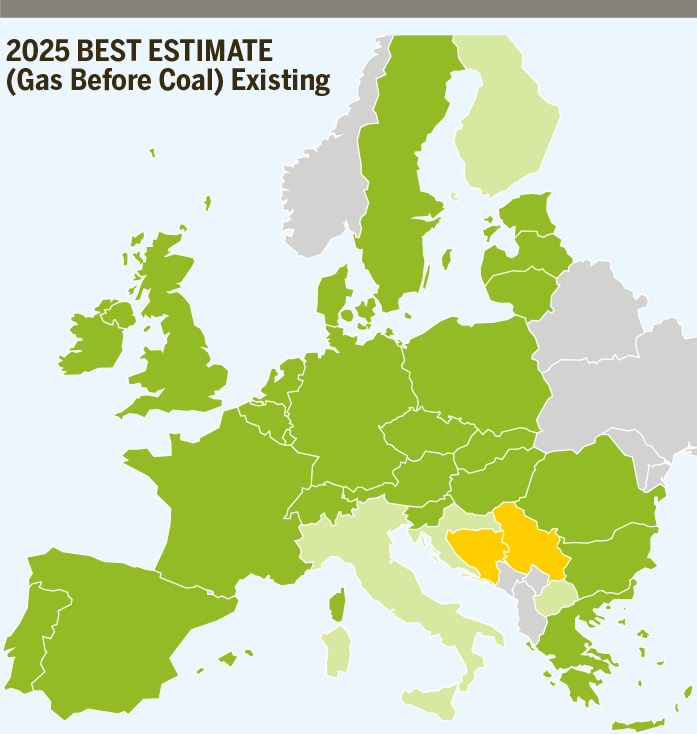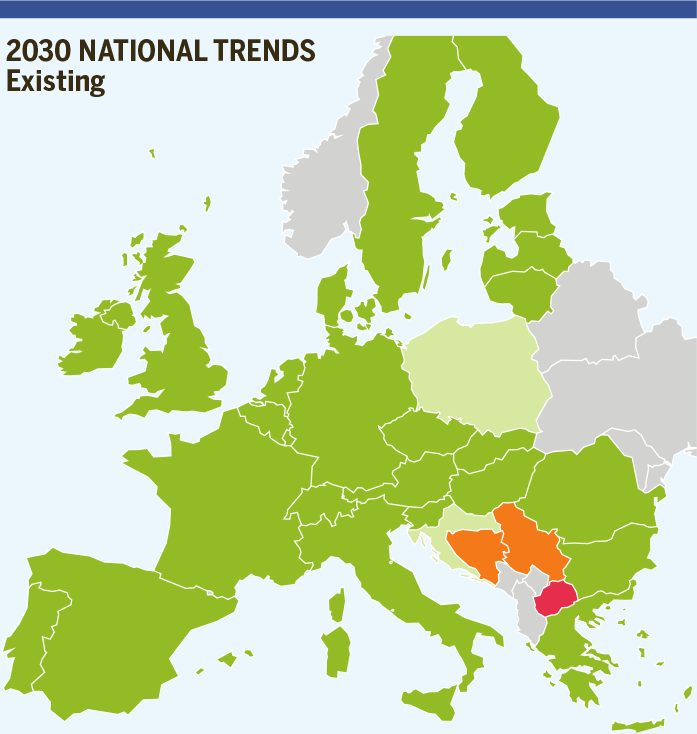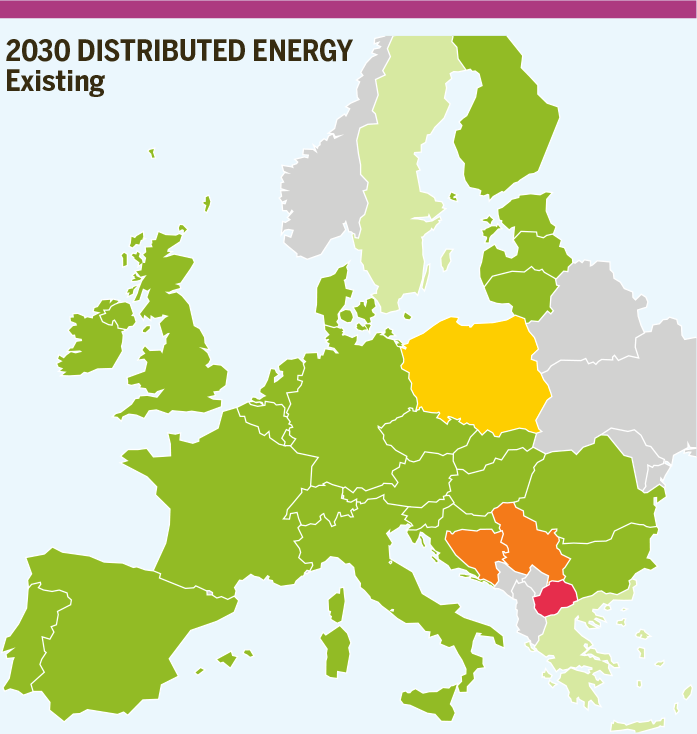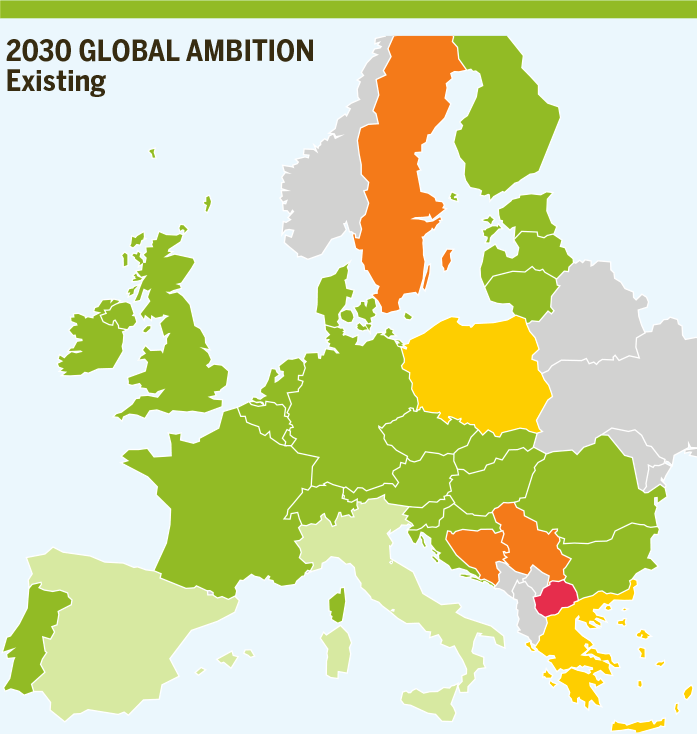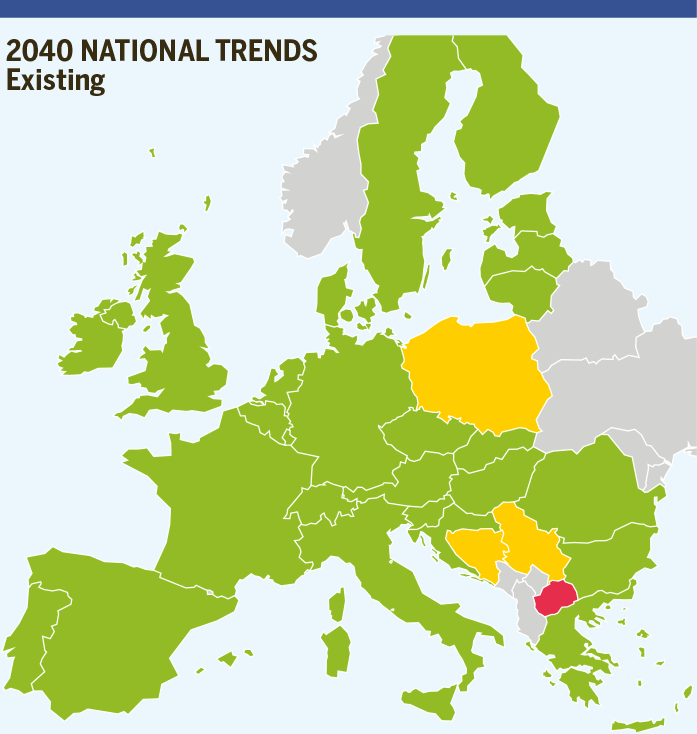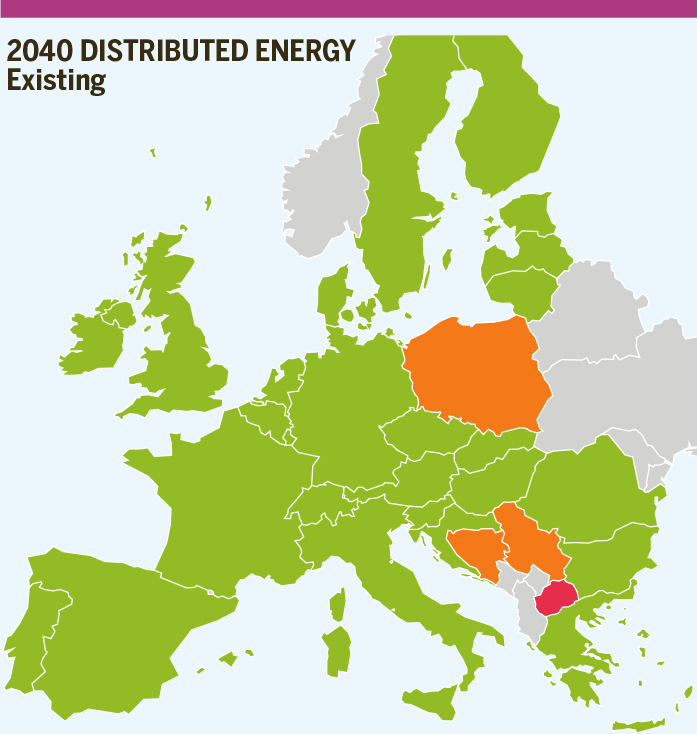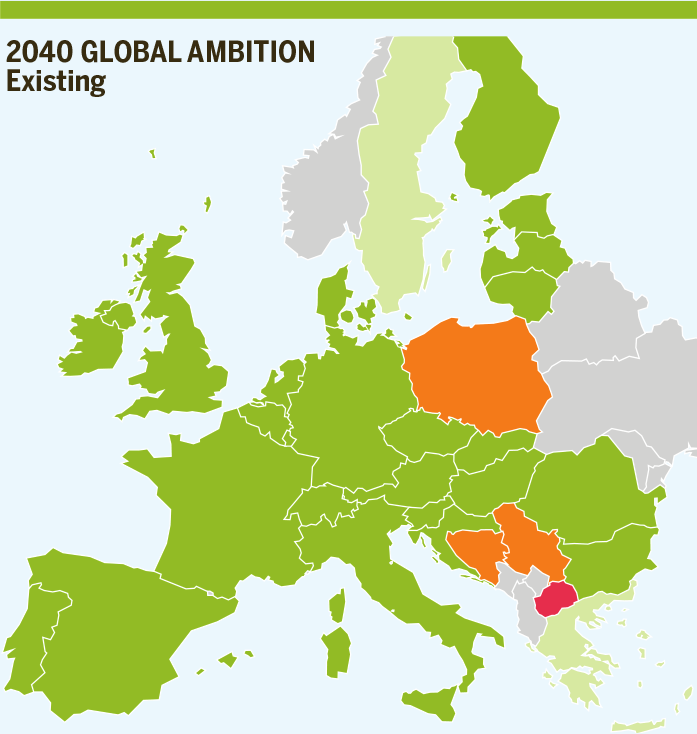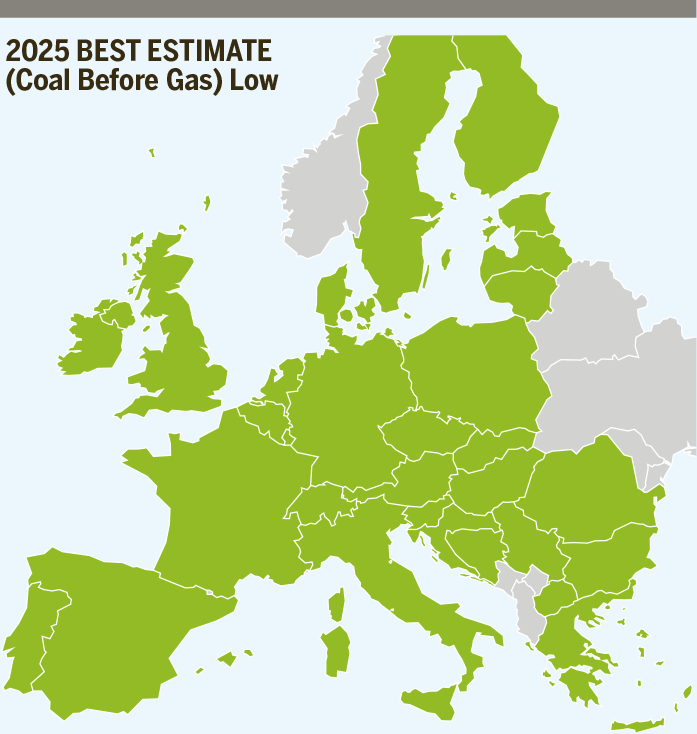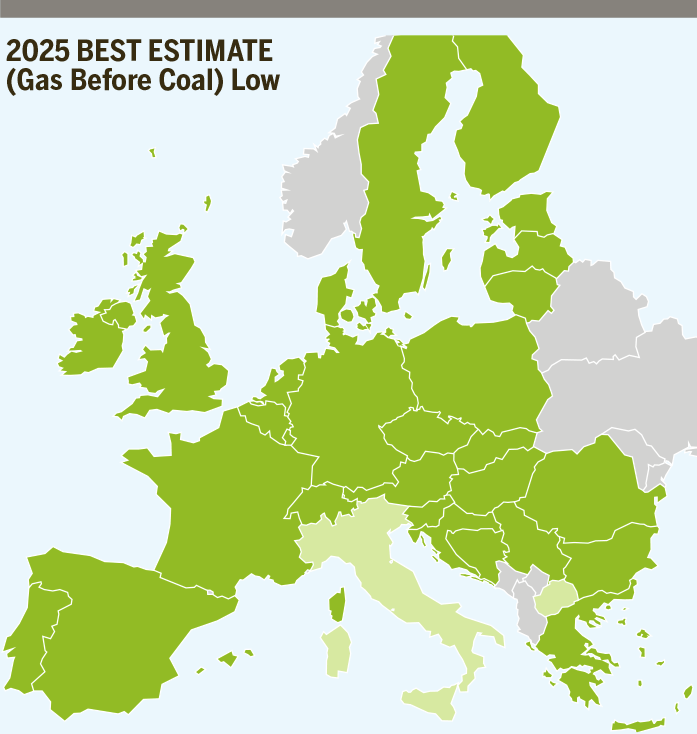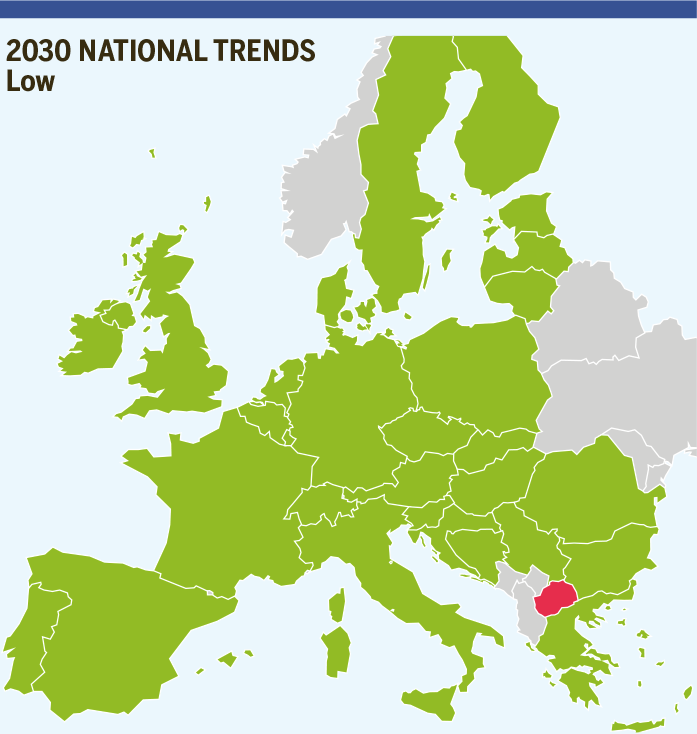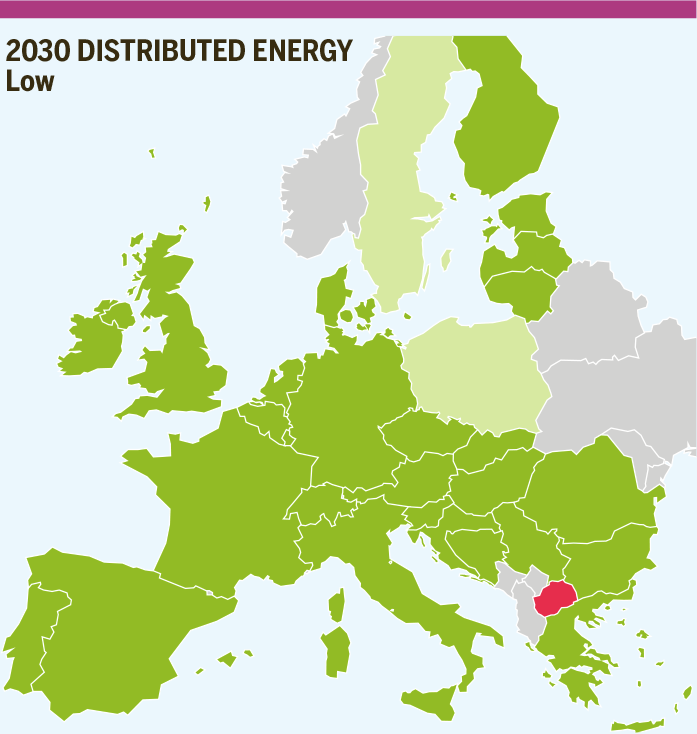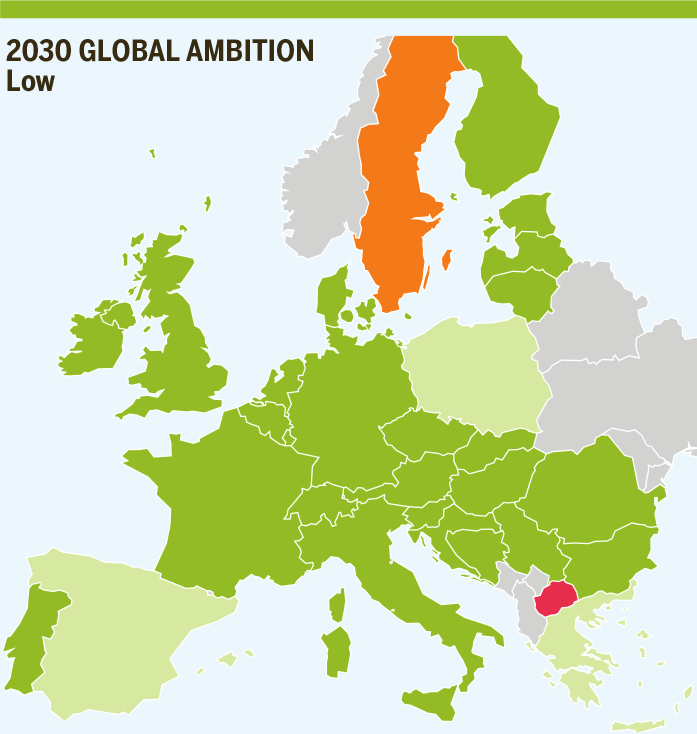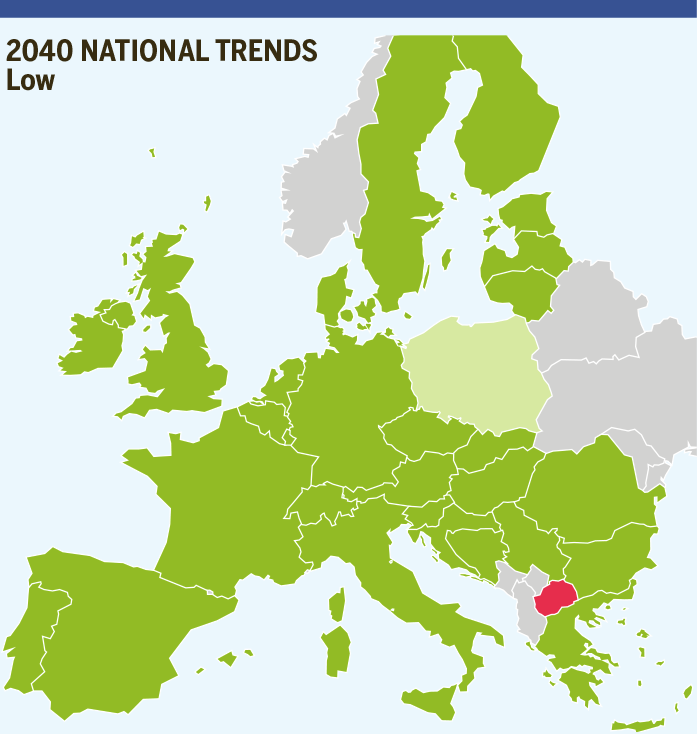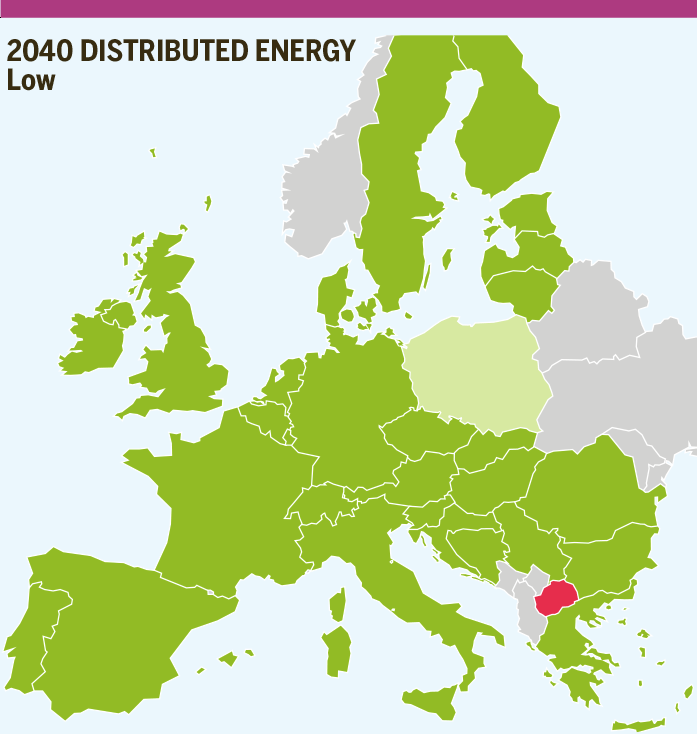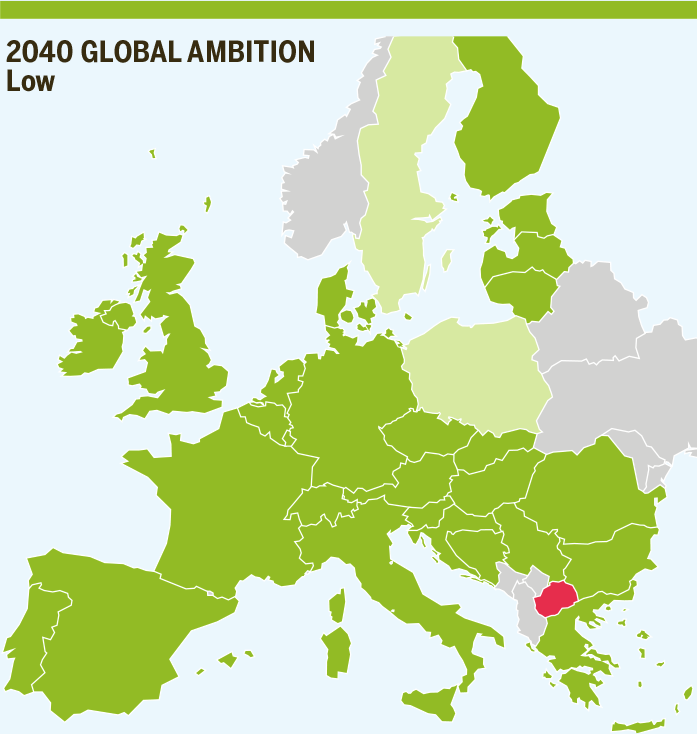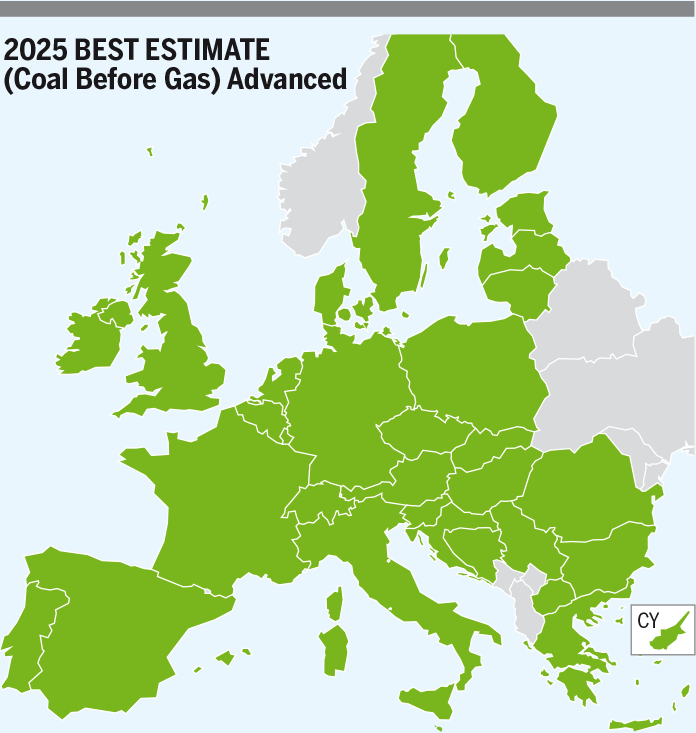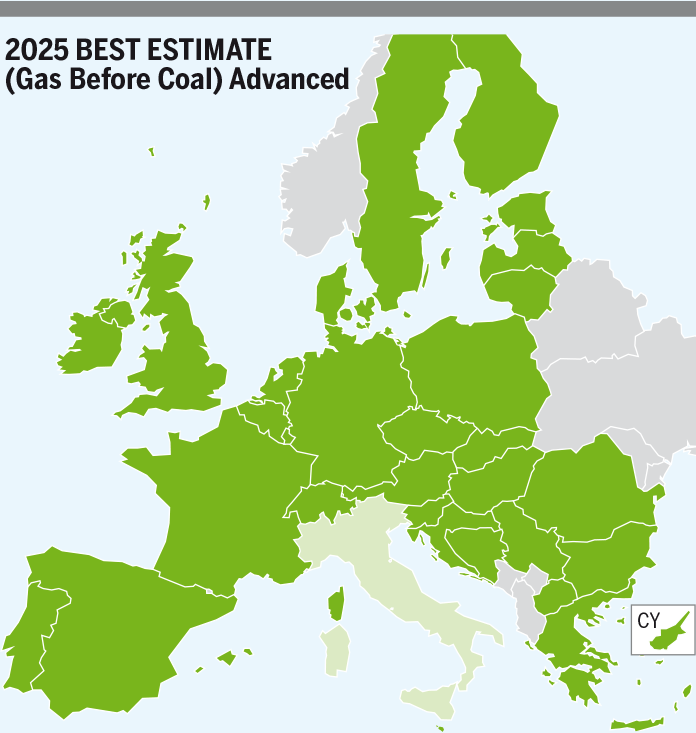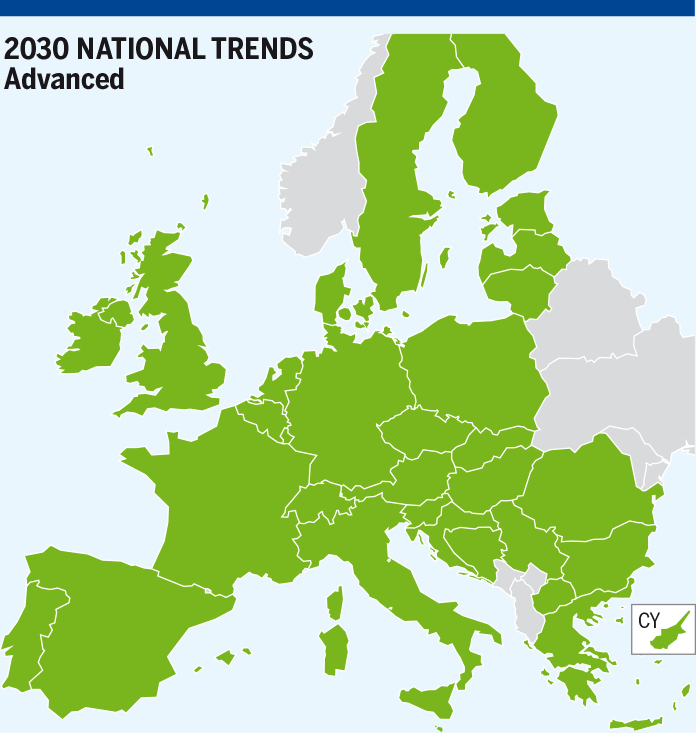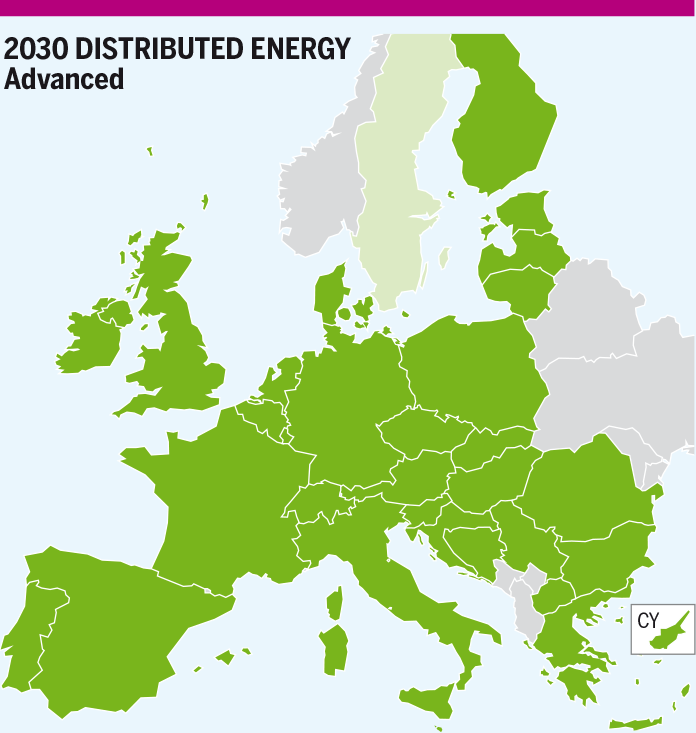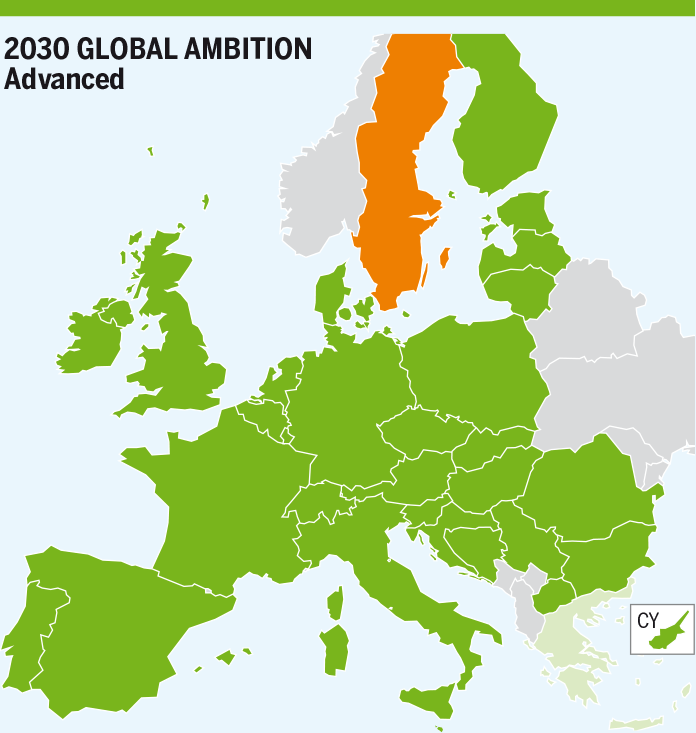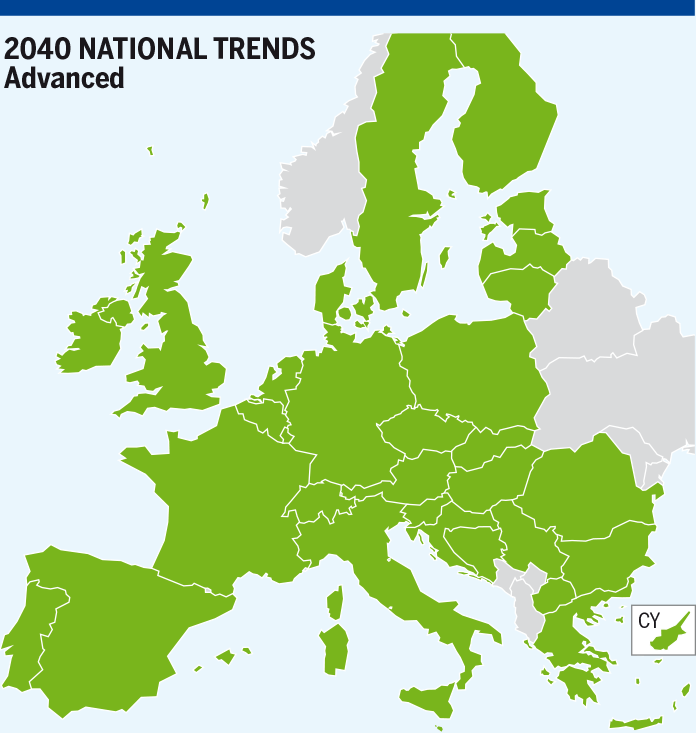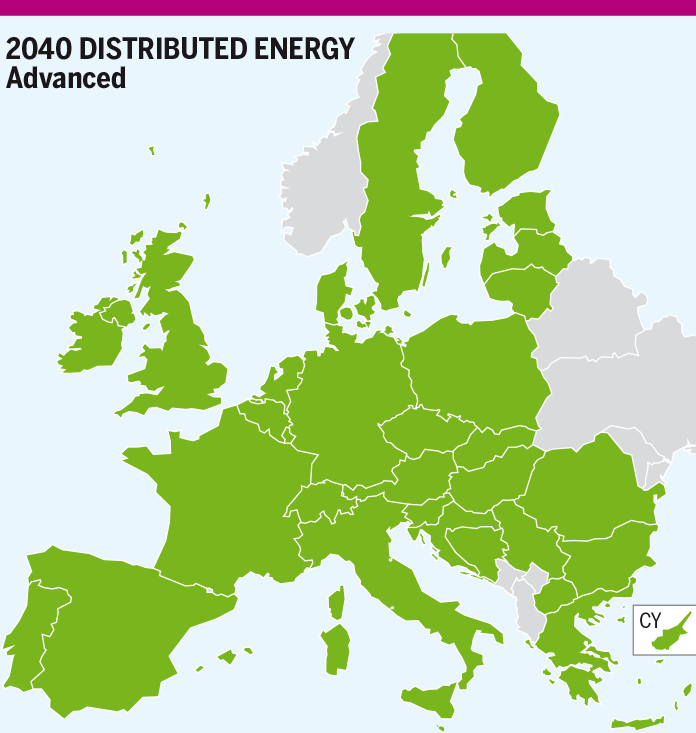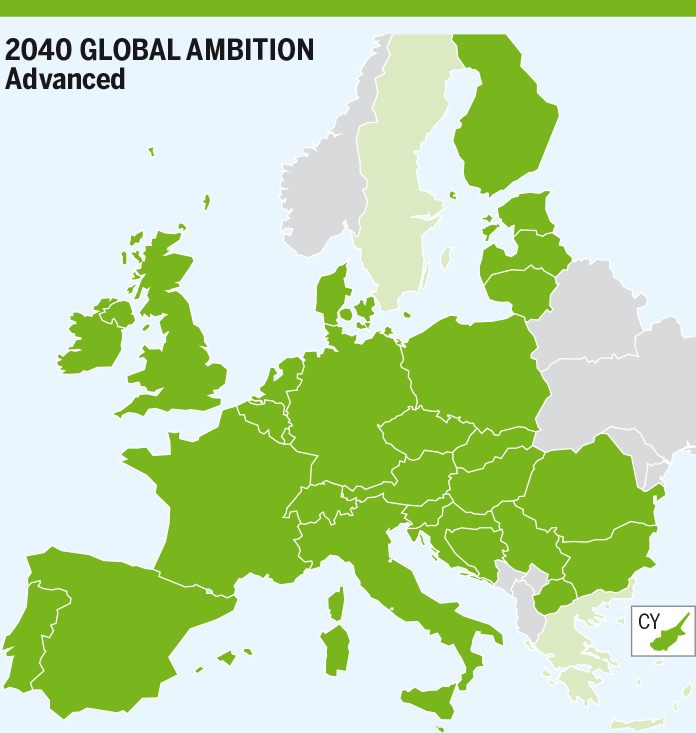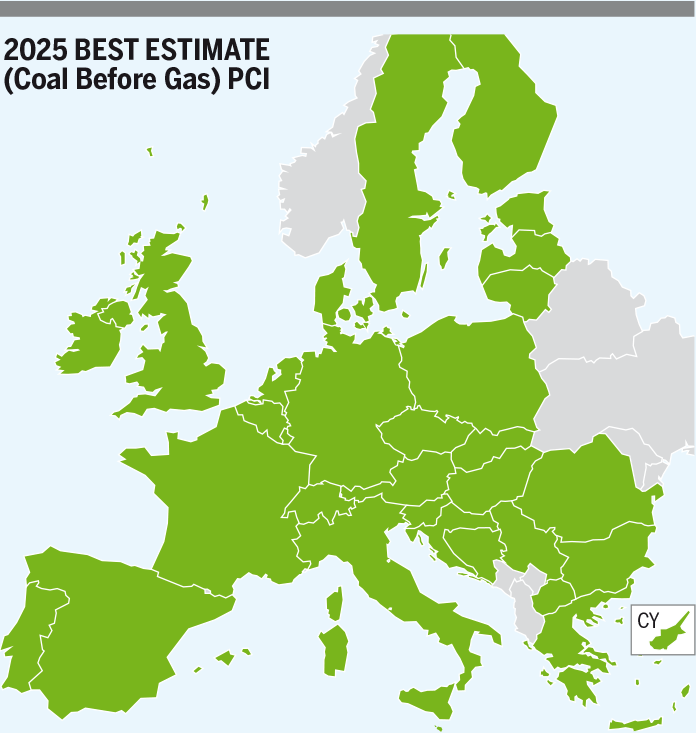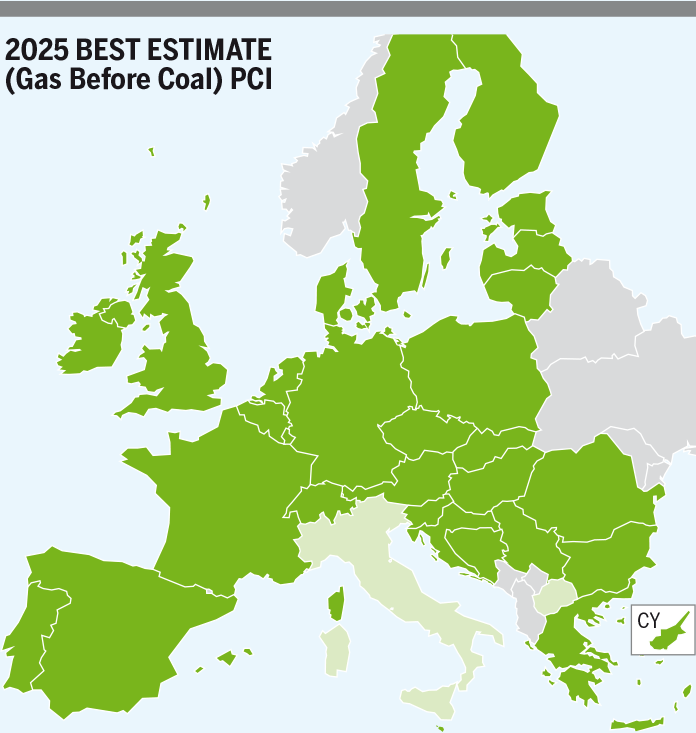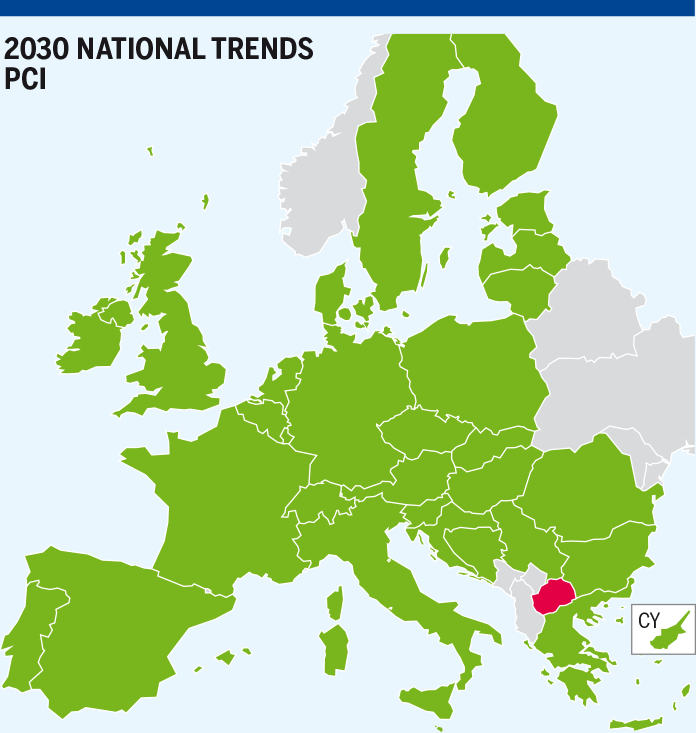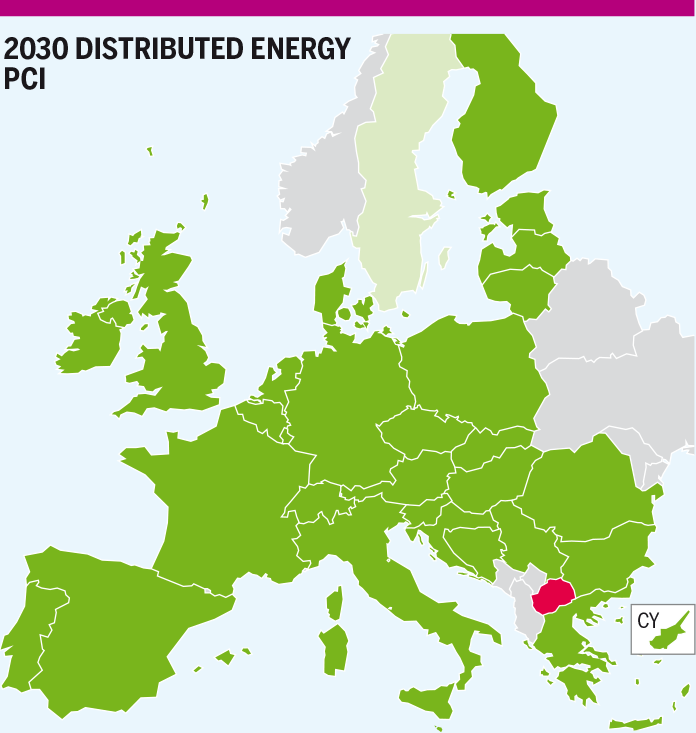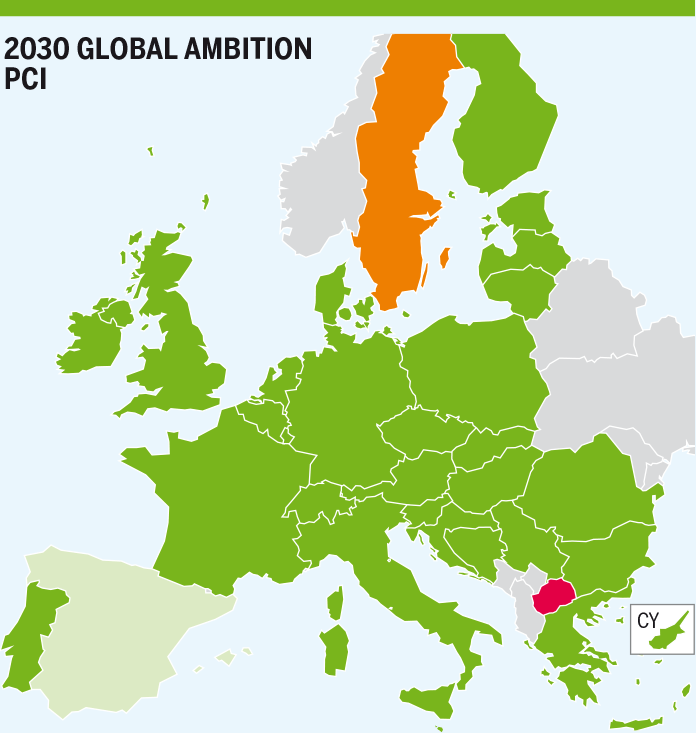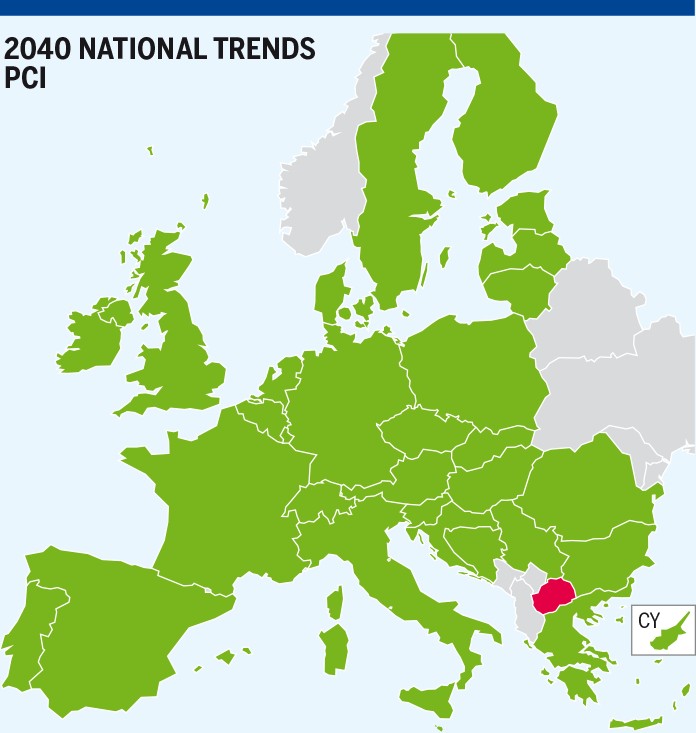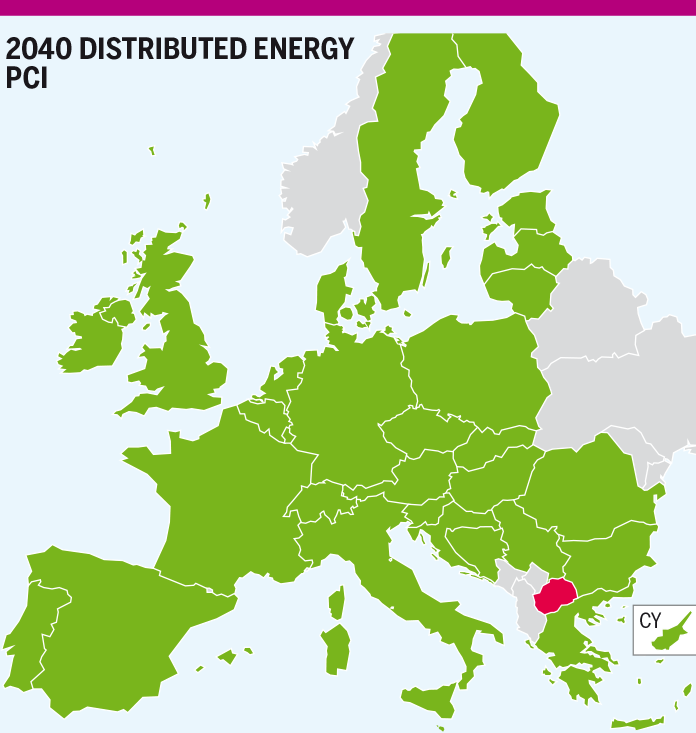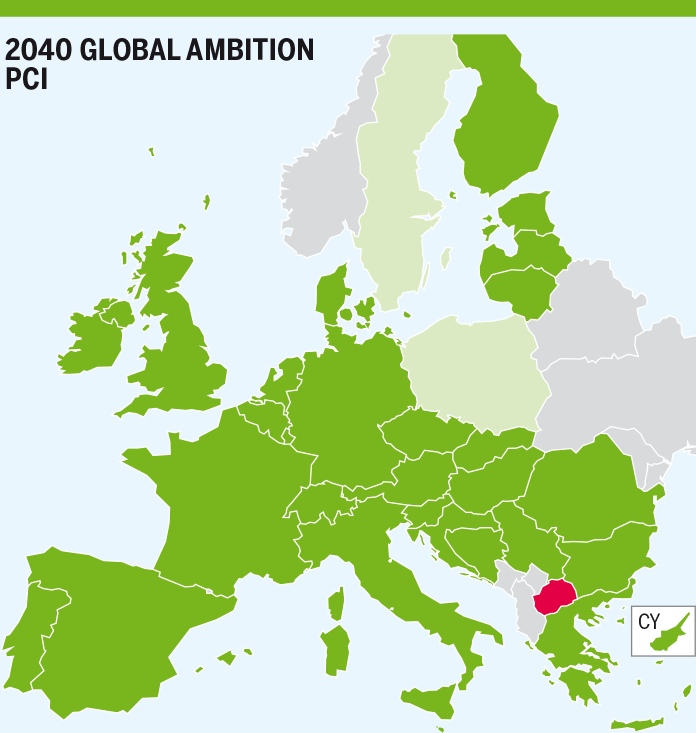4.2.4 Algerian pipeline import routes disruption
The simulation considers the disruption of all the imports pipelines from Algeria to the EU during climatic stress situations and the risk group is formed by Austria, Croatia, France, Greece, Italy, Malta, Portugal, Slovenia and Spain.
The Import pipelines from Algeria to EU disrupted in this case are:
- MEG Pipeline between Algeria and Spain
- MEDGAZ Pipeline between Algeria and Spain
- TRANSMED Pipeline between Algeria and Italy
Figure 4.94: Risk group for Algerian pipes disruption.
4.2.4.1 Peak Day
Existing Infrastructure level
Simulation results are in line with the assessment of climatic stress conditions without transit disruption. Figure 4.95 shows the evolution of the Existing infrastructure level.
Results show that mainly Italy, Portugal and Spain suffer a limited impact coming from the Algerian pipeline import route disruption. However, there is no country facing risk of demand curtailment apart from the countries already exposed in the assessment of climatic stress conditions without transit disruption.
Italy has a low remaining flexibility, bellow 15 %, in almost all scenarios and years, facing 0 % remaining flexibility in Gas Before Coal and Global Ambition 2030 driven by a high demand. National Trends 2030 is the scenario with the lowest gas demand in Italy and Distributed Energy 2040 is the scenario with the highest inclusion of renewable production coming from biomethane and power to gas.
Portugal faces 0 % remaining flexibility in Global Ambition 2030 driven by a lower national production that increases in 2040 with more production coming from renewables such as biomethane and power to gas reaching 58 % remaining flexibility.
Spain faces 0 % remaining flexibility in Global Ambition 2030 driven by high demand and low national production that increases in 2040 with more production coming from renewables such as biomethane and power to gas reaching 37 % remaining flexibility.

Figure 4.95: Existing infrastructure level: Algerian pipeline import route disruption under peak day situation.
Low Infrastructure level
Simulation results show that the commissioning of some FID projects in the area slightly improve the situation. Figure 4.96 shows the Low Infrastructure level results.

Figure 4.96: Low infrastructure level: Algerian pipeline import route disruption under peak day situation.
Advanced Infrastructure level
Simulation results show that advanced-status projects improve the situation increasing the remaining flexibility in Italy and the Iberian Peninsula in most of the scenarios. Figure 4.97 shows the Advanced infrastructure level results.

Figure 4.97: Advanced infrastructure level: Algerian pipeline import route disruption under peak day situation.
PCI Infrastructure level
This infrastructure level assesses the different scenarios under peak day demand together with Algerian pipeline transit disruption against the current European gas system infrastructure complemented with FID projects (Low infrastructure level) and all projects included in the latest 4th PCI list showing the benefits stemming from the implementation of the latest PCI list. Results are mostly in line with Low infrastructure level regarding Spain and Portugal, while for Italy PCI projects help to increase the remaining flexibility. Figure 4.98 shows the evolution of the PCI infrastructure level.

Figure 4.98: PCI infrastructure level: Algerian pipeline import route disruption under peak day situation.
4.2.4.2 2-week cold spell
Existing Infrastructure level
The EU gas system is resilient to a disruption of all pipelines from Algeria during a 2-week cold spell. No country is facing a risk of demand curtailment apart from the countries being affected for the climatic stress without disruption route case. Figure 4.99 shows the evolution of the Existing infrastructure level.
Regarding the countries with direct interconnection with Algeria supply, Italy surpasses a 15 % remaining flexibility in all scenarios apart from Gas Before Coal (9 %), which is the scenario with the highest demand. The Iberian Peninsula, Portugal, and Spain surpasses a 15 % remaining flexibility in all scenarios and years.

Figure 4.99: Existing infrastructure level: Algerian pipeline import route disruption under 2-week cold spell situation.
Low Infrastructure level
The commissioning of FID projects helps to increase the remaining flexibility all around Europe, specifically, in those countries with direct interconnection with Algeria supply. Italy surpasses a 15 % remaining flexibility in all scenarios and years. Figure 4.100 shows the Low Infrastructure level results.

Figure 4.100: Low infrastructure level: Algerian pipeline import route disruption under 2-week cold spell situation.
Advanced Infrastructure level
Results are in line with climatic stress conditions (without transit disruption) assessment. The increase of the remining flexibility, thanks to the commissioning of advanced-status projects, is notable all-around Europe, especially in those countries with direct interconnection with Algerian supply. Figure 4.101 shows the Advanced infrastructure level results.

Figure 4.101: Advanced infrastructure level: Algerian pipeline import route disruption under 2-week cold spell situation.
PCI Infrastructure level
This infrastructure level assesses the different scenarios under 2-week cold spell demand together with Algerian pipeline transit disruption against the current European gas system infrastructure complemented with FID projects (Low infrastructure level) and all projects included in the latest 4th PCI list. Results are in line with climatic stress conditions (without transit disruption) assessment. The increase of the remining flexibility, thanks to the commissioning of PCI projects is notable all-around Europe, especially in those countries with direct interconnection with Algerian supply showing the benefits from the implementation of the latest PCI list. Figure 4.102 shows the PCI infrastructure level results.

Figure 4.102: PCI infrastructure level: Algerian pipeline import route disruption under 2-week cold spell situation.
4.2.4.3 2-week Dunkelflaute
Existing Infrastructure level
The EU gas system is resilient to a disruption of all pipelines from Algeria during a 2-week Dunkelflaute. As well as for peak day and 2-week cold spell demand cases, apart from the countries being affected for the climatic stress without disruption route case, no country is facing a risk of demand curtailment.
Moreover, the gas system is able to back up the intermittent power generation ensuring flexibility to the electricity system. Figure 4.103 shows the evolution of the Existing infrastructure level.

Figure 4.103: Existing infrastructure level: Algerian pipeline import route disruption under 2-week Dunkelflaute situation.
Low Infrastructure level
Simulation results are in line with climatic stress conditions (without transit disruption) assessment. The commissioning of FID projects helps to increase the remaining flexibility all around Europe, specifically, in those countries with direct interconnection with Algeria supply. Figure 4.104 shows the Low Infrastructure level results.

Figure 4.104: Low infrastructure level: Algerian pipeline import route disruption under 2-week Dunkelflaute situation.
Advanced Infrastructure level
Simulation results are in line with climatic stress conditions (without transit disruption) assessment. The increase of the remining flexibility, thanks to the commissioning of advanced-status projects, is notable allaround Europe, especially in those countries with direct interconnection with Algerian supply. Figure 4.105 shows the Advanced infrastructure level results.

Figure 4.105: Advanced infrastructure level: Algerian pipeline import route disruption under 2-week Dunkelflaute situation.
PCI Infrastructure level
This infrastructure level assesses the different scenarios under 2-week Dunkelflaute demand together with Algerian pipeline transit disruption against the current European gas system infrastructure complemented with FID projects (Low infrastructure level) and all projects included in the latest 4th PCI list. Simulation results are in line with climatic stress conditions (without transit disruption) assessment. The increase of the remining flexibility, thanks to the commissioning of PCI projects, is notable all-around Europe, especially in those countries with direct interconnection with Algerian supply showing the benefits from the implementation of the latest PCI list. Figure 4.106 shows the PCI infrastructure level results.

Figure 4.106: PCI infrastructure level: Algerian pipeline import route disruption under 2-week Dunkelflaute situation.


